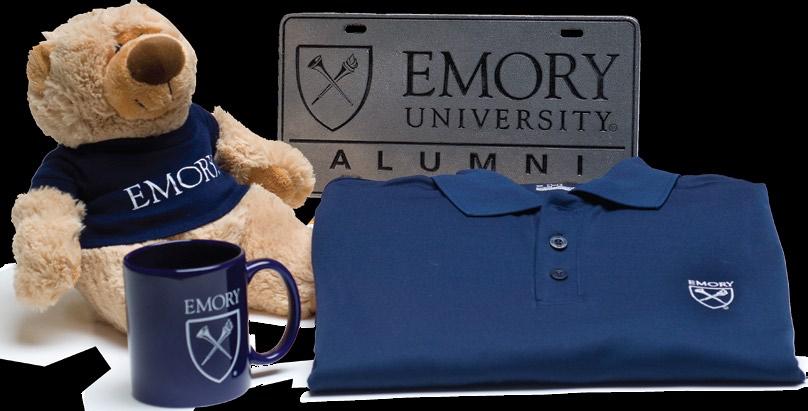Pilgrimage
Journeys of the body, mind, and spirit



In the movie The Bucket List, Jack Nicholson and Morgan Freeman star as unlikely companions who set out to complete a list of essential experiences before they die—see the Pyramids, go skydiving, drive a Shelby Mustang.
I have no idea what a Shelby Mustang is, honestly, or what’s so special about it, but I suspect that most of us have our own list of things we’d like to do—or perhaps more correctly, to be able to say we did. Some are undoubtedly unique to individuals, but others, like seeing the Pyramids, are near-archetypal experiences—the things that people travel for days, walk for miles, line up by thousands, and wait for hours to do. Then they talk about them for years.
While planning this issue of Emory Magazine, Associate Editor Mary Loftus and I decided we couldn’t properly get into the spirit of the thing without taking a pilgrimage of our own. So we decided to cross an experience off our lists and visit one of the ultimate sites of the South—Graceland. Luckily, we had an excuse in the form of a book on Elvis Presley fashion created by alumnus Michael Feder 91MBA, and we also planned a detour to Oxford, Mississippi, tracing the route that Sally Wolff-King 79G 83PhD travels with her students each year to William Faulkner country. We didn’t need much more encouragement to pile into the car—no Shelby Mustang, but my slower, safer Honda CRV —with our two middle school kids (Elvis who?) for an old-fashioned road trip.

Both my parents were born in Mississippi and grew up in the era of Elvis, so I was especially interested in gaining a deeper understanding of those influences. Mary, in addition to indulging her natural curiosity about Graceland, was determined to capture the trip on camera with the aim of posting a short video on the Emory Magazine website.
As for our twelve-yearolds, they were just happy to be out of school and on the road, eating junk and watching DVDs in the back seat. On the way to Memphis, we made them play the classic Blue Hawaii, and they gamely gave it about forty-five minutes before getting bored and switching to Jurassic Park. (Which may be why, when we discovered that you can actually buy one of Elvis’s hairs, my son said, “Oh my god. DNA . We could clone Elvis!”)
We took the VIP tour of Graceland, soaking up the 1960s décor, the fabled Jungle Room, the paneled walls lined with cases of music awards and elaborate stage costumes worn by the King. We saw the stables where Elvis rode his beloved horses and the plush basement den where he played pool. We filed by his gravesite, where even on a hot weekday afternoon there were so many people I had to elbow them out of the way, gently, to take a decent picture. Then we shared a fried peanut butter and banana sandwich—Elvis’s favorite.
Later that evening, we walked Beale Street, taking in the ambiance and attempting to interview passersby for our video. B. B. King was playing in a blues bar and the place was hopping. We caught snatches of music through a few open windows (kids can really cramp your style) and ate burgers at Huey’s.
This magazine is filled with accounts of much weightier journeys than ours: an ambitious sailing trip, an annual literary quest, an exploration of Native American reservations in Montana, a midlife flight set to the strains of Joni Mitchell. But what these travels have in common is a desire to find not just place, but purpose;
to share a common event with others across space and time; to create an experience that won’t fade into oblivion, but will take on new meaning in memory, relished and retold.
In his message for this issue, President James Wagner likens college students to “pilgrims of the mind” and universities to sites of profound transformation. I have no doubt that any one of Emory’s 3,810 new graduates would have agreed with his reverent description as they reflected on their university experience during Commencement this spring. So, too, would those hundreds of alumni who journeyed to campus to take part in the ritual once again.
Life isn’t a series of landmarks that you can check off a list. But there’s something to be said for making moments that become stories—the stories that connect us with others through shared human experience. Now, for example, I can say I’ve been to Graceland and eaten a fried peanut butter and banana sandwich. And you know, we all agreed, it was strangely delicious.—P.P.P.
features
navigating a fifty-one-foot sailboat in the British v irgin islands was the final challenge for graduates of the goizueta advanced Leadership academy.
 By Christopher Wang 03BB a 09 m B a
By Christopher Wang 03BB a 09 m B a
each autumn, a group of Southern literature students and their professor set out for Oxford, Mississippi, to seek the spirit of William Faulkner.
By s ally Wol FF -King 79 g 83 p hDelvis remains an icon, judging by the crowds that gather at graceland—and the success of a new book by
Michael Feder 91MBa By m ary J. l o F tus
By m ary J. l o F tus
a journey to northern Cheyenne and Crow reservations in southeastern Montana is filled with unexpected lessons for those who learn to listen.
By gary s h au K 91 p h DHow Joni Mitchell’s hejira inspired a kindred soul to become a “hitcher on the free, free way”—at least for a little while.
By s usan Carini 04 gdepartments
3
Letters
4 Of note
Winship named nCi Cancer Center
Braxton resigns
Flu Fighters
Documenting Sustainability
inspiring Scientists
Legitimate Children
Dueling Dooleys
i, robot
For many who give, philanthropy is an act of love.
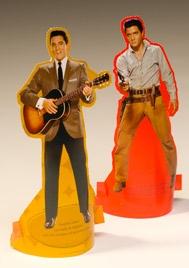
editor paige p parvin 96g
paige.parvin@emory.edu
art Director
erica endicott
production manager
Stuart Turner
Contributors
Susan Carini 04g
Beverly Clark
nina Dutton 11C
gary Hauk 91phD
Breanna McDaniel 09OX 11C
eric rangus
alice Walker
Christopher Wang 03BBa 09MBa
Franchesca Winters 10C
Sally Wolff-king 79g 83phD
associate editor Mary J. Loftus
mary.loftus@emory.edu
lead photographer
kay Hinton
Copy editor
Jane Howell
photographers
ann Borden
Bryan Meltz
The recent issue of Emory Magazine is exceptionally well done. I have received the magazine for many years, but questioned the lack of diversity in coverage, especially given the demographics of the metro area. Emory is an outstanding institution; however, in my opinion, it hasn’t positioned itself as having significant connections in certain ethnic communities. Emory’s value to the Atlanta community, in particular, is immeasurable; we simply need to enhance its image within those communities.
Linda Torrence Atlanta publisher, Girl Friends Health Guide for Women of Color Tuckeron the cover: Festival of Lights, ©2000 by John august Swanson. Serigraph, 30 ¾ x 24 inches. www.johnaugustswanson.com.
Full-color posters and cards of Swanson’s work are available from the national association for Hispanic elderly, 234 east Colorado Blvd., Suite 300, pasadena, Ca, 91101; 626.564.1988.
see story on page 9.
emory magazine editorial advisory Board
John Dunn
Editor Emeritus, georgia Tech
Magazine
Crystal edmonson 95C
atlanta Business Chronicle
Samantha ehrlich 10C Copresident, Student Alumni Association
ginger Cain 77C 82g University Archivist and Director, Library Public Programs
Ozzie Harris
Senior Vice Provost for Community and Diversity
Tim Hussey
Director, Marketing and Communications, School of Law
Jan Love
Dean, Candler School of Theology
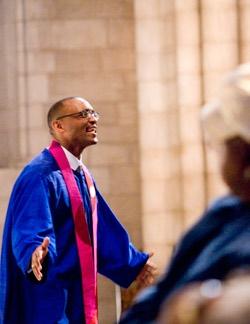
Dan Macaluso
Vice President for Development
karen Martucci Director, Academic Services, Oxford College
Jeff Molter
Associate Vice President, Health Sciences Communications
Santa Ono
Vice Provost for Academic Initiatives
isabel Wilkerson
Cox Professor of Journalism ex officio
Susan Carini 04g
Executive Director, Emory Creative Group
allison Dykes
Vice President for Alumni Relations
gary Hauk 91phD
Vice President and Deputy to the President
ron Sauder
Vice President for Communications and Marketing
Emory Magazine (US p S-175-420) is published quarterly by emory Creative group, 1762 Clifton road, plaza 1000, atlanta, g eorgia 30322, and is distributed free to all alumni and to parents of undergraduates, as well as to other friends of the University. address changes may be sent to the Office of alumni and Development r ecords, 1762 Clifton r oad, p laza 1000, a tlanta, g eorgia 30322 or eurec@emory.edu. i f you are an individual with a disability and wish to acquire this publication in an alternative format, please contact paige p parvin (address above) or call 404.727.7873. periodicals postage paid at atlanta, g eorgia, and additional mailing offices. p OSTM a ST er : send address changes to the Office of a lumni and Development r ecords, 1762 Clifton r oad, p laza 1000, a tlanta, g eorgia 30322. no. 109001-7 © 2009, a publication of emory Creative group, a department of Communications and Marketing.
photos courtesy of emory photo/video. To see a broad portfolio and arrange a shoot, or to view the video collection and commission a video, go to www.photo.emory.edu.
I have read with much satisfaction almost every word in the latest issue of Emory Magazine. It is gratifying to read of all that is happening at Emory to further improve race relations in our society. In the 1930s, Emory contributed much to my commitment to seeking improved black-white relationships. The account of the desegregation of Emory and the roles in this played by Fink, Bowden, and Martin is of special interest to me. Having been president of Randolph-Macon Woman’s College from 1952 to 1978, I know from my own experience the struggles in bringing about desegregation of a college.
William F. Quillian Jr. 35C Lynchburg, VirginiaI’ve been reading Emory publications of all varieties for sixty years, including writing and editing some as a student. Rarely, if ever, do I remember an Emory publication more representative of the best of journalism than your spring issue of Emory Magazine. As a close observer professionally and a participant in the media world of Atlanta since 1948, I especially enjoyed Hank Klibanoff’s “True Story of the Atlanta Times.” With public relations and advertising agency roles for many years, I had relationships with most Atlanta media organizations and many of their respective staffs, including the Atlanta Times. But I learned much that I either never knew or forgot. I was especially pleased to read about Luke Greene,
who was my city editor on the Atlanta Constitution where I was a reporter in the early fifties after graduating from Emory. Luke Greene was a soft-spoken, highly respected newspaperman, who skillfully, along with the late Lee Rogers and other associates, guided the news coverage and editing of that paper whose editor was the famed Ralph McGill. Luke treated young reporters like me with the same respect he accorded a group of more experienced “older hands,” including some of the South’s best newspaperwomen, Celestine Sibley being one. He and Lee Rogers gave me many interesting assignments, including covering three or four times a week for about a month one of Billy Graham’s first “crusades” at the old Ponce de Leon ball park. I also interviewed Congressman James C. Davis, one of the principals of the Atlanta Times, in a downtown hotel long before the Times was founded. Mr. Klibanoff’s story utilized the papers at Emory of my good friend Joe Cumming. . Joe and his predecessor at Newsweek’s Atlanta bureau, Bill Emerson, were among the best newsmen ever to report on the South in dynamic days. I’m glad to see his papers utilized to such good purpose in a good story.
Richard E. (Dick) Hodges 50C MariettaThere is an important fact left out of the story about the Atlanta Times and Charles Weltner’s [congressional election] defeat of James Davis. That defeat was made possible by the overturning of the county unit system. Charles and a group of progressive
pastors and lawyers had brought suit in court to change the way that votes were counted in Georgia, and it resulted in the defeat of the county unit system, which determined the way votes were counted. That court decision remains the law in Georgia today. Jim Davis stood for everything destructive and corruptive of the Southern system of segregation. Charles’s victory meant a Southern vote in support of the landmark civil rights legislation enacted under Lyndon Johnson.
Nyta Weltner Richardson ConyersI was delighted to read Stacey Jones’s thoughtful and moving piece on the Transforming Community Project (TCP) in the spring 2009 issue (“Facing Race”). For the past four years it has been my privilege to lecture each spring to the annual TCP facultystudent seminar, exploring the dynamics and legacies of slavery in the early history of Emory College. Readers will be interested to note that as of last spring, the historically African American section of the Oxford City Cemetery now contains a handsome memorial, erected by the city of Oxford, honoring those many persons of color buried in the cemetery, who, in slavery and freedom, laid so many of the foundations of Emory College and the city of Oxford. I should correct a minor historical inaccuracy in the article. At the time of the fateful May 1844 conference of the Methodist Church, which led to the church’s nearly century-long schism between northern and southern wings, Bishop Andrew did not own only two slaves (although this is erroneously asserted in many published sources). In addition to the enslaved woman known as Kitty (whose origin remains mysterious) and the enslaved man known as Billy (the property of his late, first wife Ann Amelia, who died in 1842), he also was the legal owner of at least fourteen other enslaved men and women who had come into his household through his marriage to his second wife, Ann Leonora Greenwood, in January 1844. We know the names of these fourteen persons because on April 12, 1844, Bishop Andrew and his close friend, Emory College President Augustus Longstreet, participated in a complicated legal transaction, evidently aimed at disguising the extent of the Bishop’s slaveowning, in anticipation of abolitionist criticism at the upcoming New York conference. Bishop Andrew deeded, for ten dollars, fourteen slaves to President Longstreet, who then promptly transferred the slaves back to Bishop Andrew and his wife in the form of a trust. I recount the diverse stories of all these
enslaved persons in my forthcoming book on how the Andrew-Kitty story has been remembered over time, in white and African American communities. In support of this research, I would be enormously grateful to any readers of Emory Magazine who might be willing to share their recollections of the Andrew-Kitty story or of the slave quarters known as Kitty’s Cottage, especially during the time the building served as the Kitty Cottage Museum at Salem Campground.
Mark Auslander Department of Anthropology Brandeis UniversitySomeone once coined the phrase “the past is prelude to the future.” The Prelude article provided interesting and informative local cultural perspective of the struggle for equality that took place in the schools and continues today in various arenas. Emory’s complexity and diversity is unique because its mission is to both acknowledge our differences and unify us in a common vision of service to humankind, which is a wonderful goal.
Ann Byrd Bullock-MacGowan 83MBA Vienna, VirginiaI read with interest the spring issue of Emory Magazine with its emphasis on the civil rights movement in Atlanta. I was dismayed, however, by the lack of mention of the involvement of Emory students in that historic struggle. A very small minority of students were active in the biracial Committee on Appeal for Human Rights (later subsumed in SNCC ) during the fall, winter, and spring of 1960 to 1961. Emory students and a handful of Agnes Scott students participated in sit-ins, demonstrations, and picket lines (especially around Rich’s Department Store, where Dr. King was arrested) in downtown Atlanta with the students from the Atlanta University colleges. The Emory students were subject to expulsion if arrested (which the movement leadership allowed us to avoid) while the Scott women were subject to expulsion for mere participation. Thus, we had to pick them up on street corners in Decatur! Our membership included undergraduates, graduate students, and medical students. The high points included election day 1960, the confrontation with the Klan in late November, and the desegregation of the downtown lunch counters in March, 1961. The anticlimax came with Malcolm X’s appearance to denounce the achievement at the victory celebration. The Emory Wheel reflected majority opinion on campus, however, with its over-the-masthead editorial
entitled “Radicals Threaten Emory’s Name” in the issue of November 10, 1960. It’s enough to raise a smile even now. Old times there are not forgotten!
Errol M. Clauss 61G 65PhD Clemmons, North CarolinaThe controversy over Dr. Braxton’s compensation (“The Audacious Thing”) looms larger to me than it does in the Emory Magazine article, where one might almost miss it. With that $600,000 figure in mind, I had a hard time appreciating the article’s description of his many accomplishments. Thank you for the article on the Emory Woman’s Club, especially since I know Blair Major and Eleanor Joslin. The article told me a lot about the club that I didn’t know. I also appreciated the mention of Randy Fort in Prelude. He was a family friend. Finally, thank you for the fine work you do on Emory Magazine. I always look forward to seeing it.
George Wiley 71T 78PhD Baldwin City, KansasThis article about an energetic, courageous African American pastor touches on the question of biblical support for the institution of human slavery. In fact, slavery existed as a global phenomenon despite, and perhaps partly as a result of, widespread geographical extension of both Christianity and Islam. Indeed the eleven million Africans taken trans-Atlantic to the “new world” fueled trade and industry enriching primarily the coffers of nations professing Christianity. The answer to this paradox lies in the concept of Progressive Revelation, elucidated in the mid-nineteenth century by Baha-u-llah. It is high time that a systematic, in-depth study of the life and teachings of this majestic, nineteenth-century, unschooled teacher and of the highly diverse worldwide Baha’i community of his followers be undertaken. Thank you for this stimulating and informative article on Reverend Brad Braxton and the opportunity to express thoughts generated by reading it.
Ashburn P. Searcy 59C KennesawWhen facing multiple melanomas, Nell Phelps of Villa Rica had no doubt where she wanted to receive treatment— Emory’s Winship Cancer Institute (WCI).
“It was the first place I wanted to go,” says Phelps, eighty, who drives about forty-five miles each way to be seen at
• NCI cancer centers have become the model for research and treatment, translating laboratory findings into the next generation of therapies and cures.
• Clinical trials developed and carried out at nCi cancer centers have resulted in cures for many childhood cancers, Hodgkin’s disease, testicular cancer, and leukemia, and improved treatments for solid tumor cancers including colon, lung, and breast.
• side effects from even the most intensive therapies have been reduced by nCi cancer centers’ work to refine treatments and reduce toxicity.
• NCI cancer centers have been the site of key research discoveries, including cancer-related genes that promote or suppress tumors. Hundreds of genes have been identified, and this knowledge has been used in cancer prevention, detection, and treatment.
Winship. “My first surgery for melanoma was there in 1996, and it came back in 2005.”
To Phelps’s relief, her most recent test revealed no cancer. Previously, however, she had to visit Winship every three months, and had several melanomas removed. “The staff tries to do things to make it easier,” she says. “Since I live out of town, it was important to me to be able to schedule my blood work, oncologist, X-rays, and other treatments all on the same day.
“I was so happy to read in the newspaper that they got that designation as a cancer center,” Phelps adds.
great expe C tations: Winship Cancer i nstitute joins the nation’s nC i cancer centers. at the announcement in a pril were (from left) g eorgia Cancer Coalition Ceo Bill todd, WC i Director Brian l eyland-Jones, g overnor sonny perdue, president James Wagner, and e xecutive Vice president for h ealth affairs Fred sanfilippo.
In April, Winship became Georgia’s first National Cancer Institute (NCI) Cancer Center, a coveted designation that is expected to bring in more public and private research dollars and attract top doctors and scientists to Atlanta. “We are on the brink of great advances in cancer research, and our ability to translate those advances into therapy is significantly enhanced by the NCI designation,” says Fred Sanfilippo, executive vice president for health affairs.
emory president, professor of neurology named to aaas president James Wagner, an engineer, teacher, and scientist, and William Timmie professor of neurology Mahlon DeLong, an expert on the brain’s role in movement and movement disorders, have been elected fellows of the american academy of arts
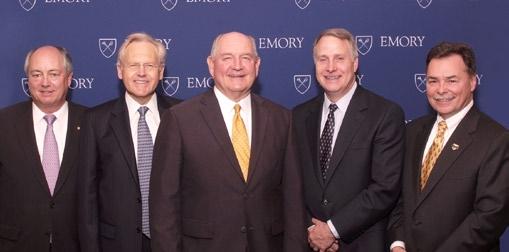
Thirty-five thousand Georgians get cancer every year, according to Governor Sonny Perdue. “Through initiatives like the Georgia Cancer Coalition and the Georgia Research Alliance (GRA), we are working hard to eliminate this disease,” he said. “Winship has served as a model in establishing collaborative research programs and in working statewide to address the pressing issues related to treatment, education, and access to care for cancer patients.”
The NCI will give nearly $4.3 million to Winship during the next three years
emory among 2009 “great Colleges to Work For” emory University has been named to the honor roll in the Chronicle of Higher Education’s 2009 great Colleges to Work For program, its second annual nationwide survey of forty-one thousand administrators, faculty, and staff of two- and four-year colleges and universities.
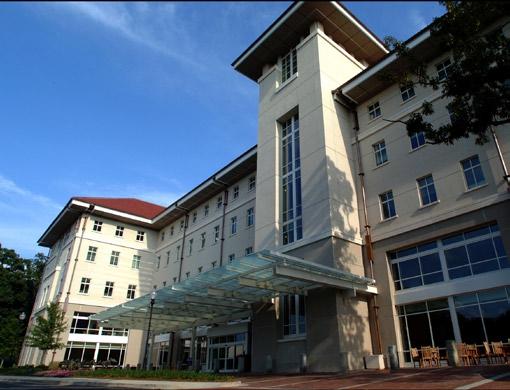
to expand its research into cancer’s causes and cures. Many clinical trials, experimental treatments, and new technologies are available only at the nation’s sixty-five NCI cancer centers. “This enables us to continue to develop research initiatives that will result in new therapies for patients throughout Georgia and beyond,” says Brian Leyland-Jones, WCI executive director and a GRA Eminent Scholar. “Robert Woodruff’s vision— that no one should have to leave Georgia to receive excellent cancer care—is alive and well in Winship.”
Emory has been steadily working for many years to receive an NCI designation, which it applied for some fifteen years ago but did not receive. Cancer centers must demonstrate the highest quality research, patient care, education, and community outreach.
Brad Braxton 99phD, who was featured on the cover of the spring 2009 issue of Emory Magazine, recently announced his resignation as senior minister of the riverside Church in new york City. His decision to leave riverside after nine months as pastor comes amidst growing discord in the congregation.
“The decision to resign seemed to be a prudent pastoral act,” Braxton says. “By stepping down, i hope the church will be able to address the internal structures that hinder the leadership of any pastor and to resolve the tensions so that the congregation, along with a new senior minister, can move forward in unity.”
Braxton was selected to lead the landmark church last September after an exhaustive search process. But the week before his formal installation in april, a group of members mounted a protest, objecting to Braxton’s compensation package and his leadership style. They went to the State Supreme Court in Manhattan and sought to halt the ceremony, but the judge refused, asking that both sides try to find compromise.
“any congregation of this size, with nationally renowned pastors who tend to have long stays, is likely to experience tensions in the transition to a new leader of a similar stature,” says Jan Love, dean of Candler School of Theology. “it takes time for the congregation and the pastor to get to know one another and adapt. Sometimes the chemistry just doesn’t work.”
In three years, the NCI will review Emory’s designation for a five-year renewal. Recently, Emory also was recognized as one of the top-fifty cancer centers in the country by U.S. News & World Report and received the Blue Cross Blue Shield Designation for Treatment of Rare and Complex Cancers. M.J.L. institute for Drug Discovery created an emory institute for Drug Discovery (eiDD) has been established to carry out early stage discovery and drug research while training the next generation of researchers. The multidisciplinary eiDD will focus on neglected diseases, global partnerships, and mentored research.
at issue are the core identity and mission of the church, a widely recognized center of liberal activism and progressive theology known for its diverse, interracial membership. according to coverage of Braxton’s tenure in the New York Times and other media, dissidents in the
congregation are concerned that the church is drifting away from its social activist history and toward a more conservative, traditional form of religious practice.
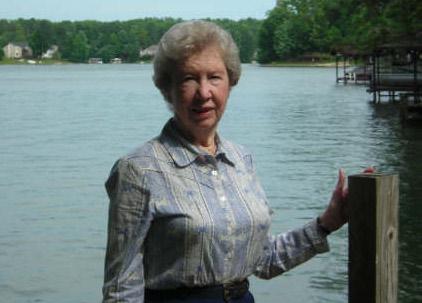
race and generational differences are also at play. Black membership increased markedly under Braxton’s predecessor, the renowned James Forbes, whose preaching style was more evangelical than that of previous riverside pastors. The shift in tone and direction made some longtime members uneasy.
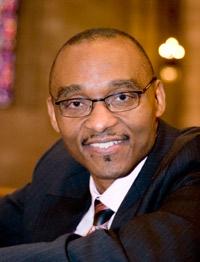
“i had become the embodiment of long-standing divisions in the congregation concerning governance structures, the balance of power between the laity and the clergy, the relationship between spirituality and activism, and faithful manifestations of multicultural worship,” Braxton says.
“i do think leading a multicultural congregation is a very tough challenge for any pastor,” says Love, who was a member of a historically black church for more than twenty years. “There are multicultural congregations that succeed, and this one has, by and large, but it’s tough to meet everyone’s expectations in a way that will help everybody rise to be their best rather than falling into factions.”
Braxton says he and his family plan to leave new york later this summer and “take a few months for renewal.”
“He’s young and energetic and deeply committed,” Love says, “and i expect him to continue to be one of the nation’s leading pastors and scholars.”—p p p
anthropologist receives Darwin achievement award goodrich C. White professor george armelagos, a pioneer in bioarcheology (the study of skeletal remains of human populations), received the Darwin Lifetime achievement award from the american association of physical anthropologists for his studies of evolution and human diet.
Late on the evening of April 22, Hubert Professor of Global Health Carlos del Rio 86mr received a call at home from the secretary of the treasury in Mexico, who is also a good friend.
“Please tell me all I need to know about swine flu,” he said. “I am going to an emergency meeting with the president to discuss a possible outbreak.”
The next day, del Rio was on a plane to Mexico—his home country, and where he attended medical school—and was soon working with colleagues in Mexico City to try to understand the outbreak, develop sound policies, and serve as a liaison with the Centers for Disease Control and Prevention (CDC ).
“On one side the city was empty, like a ghost town. On the other the population was frightened and anxious, asking for information,” he says. “In the hospitals, there was a sense of crisis. Emergency rooms were full of patients with influenza-like illness, and wards and ICU s were full of patients with viral pneumonia.”
On June 11, the World Health Organization (WHO) declared H1N1 the first pandemic in forty-one years, with the disease present in more than seventy countries. By midsummer, there were more than thirty-seven thousand cases in the United States, including 138 in Georgia; the first student case at Emory was announced on June 19.
out B rea K : hubert professor of global health Carlos del rio was one of the first experts called when the h1n1 virus (above, as seen by an electron microscope) broke out in his home country of mexico.

Del Rio is just one of dozens of scientists at Emory working to stem the H1N1 (swine flu) outbreak, advising public health and government officials here and abroad, developing diagnostic tests and therapies for H1N1 , and working on producing quick, effective vaccines.
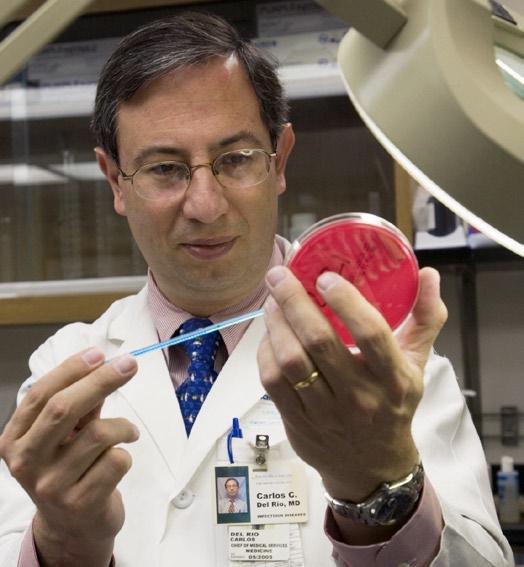
A group of Emory’s infectious disease experts, vaccine scientists, immunologists, and microbiologists helps make up the Emory-University of Georgia Influenza Pathogenesis and Immunology Research Center, one of six national NIH Centers of Excellence for Influenza Research and Surveillance. According to Vice President for Research David Stephens, this network of centers is directed to be on the front lines in a pandemic.
SUMM er 2009
Jones scholars will study at st. andrews in scotland
The 2009 Bobby Jones scholars and areas of study: Kevin Kelly 09C (peace and conflict), afeef nessouli 09C (Middle east and Central asian studies), Katherine sheehan 09C (environmental sciences and history), Joel leogrande 09C (literature). marie Walters 09C (neuroscience) is the Jones fellow.
“The pairing of Emory’s expertise with strengths at UGA in animal pathology creates a uniquely effective combination for studying crossover viruses such as swine flu,” says Richard Compans, director of the Emory-UGA center.
This unique flu strain—which includes genetic material from human, avian, and swine flus—can spread from person to person. Scientists in Emory’s flu research center are looking at how the H1N1 virus enters cells, how it is transmitted, and whether prior exposure to other influenza viruses may help immune responses to the new virus.
Upon his return to Atlanta, del Rio joined a think tank of outside experts who act as advisers to the CDC ’s Influenza Team. Foege Professor of Global Health Keith Klugman is also a member of the group. “My role is to consider bacterial infections that may cause severe pneumonias associated with influenza epidemics,” he says. Associate Professor
Vaccine Center director elected to nas immunologist rafi ahmed, director of the emory vaccine Center, professor of microbiology and immunology in the School of Medicine, and a georgia research alliance eminent Scholar, was elected to the national academy of Sciences for his discoveries on immune memory.
of Pathology Jeannette Guarner worked with colleagues in Mexico to obtain autopsy/biopsy materials, which she took to the CDC for testing.
Emory Vaccine Center Director Rafi Ahmed and colleagues, working long hours in the lab, have discovered a way to speed up the production of large quantities of infection-fighting antibodies, called human monoclonal antibodies, that can boost the immune system. These antibodies, which could target H1N1 , are created by using just a few tablespoons of blood drawn from volunteers inoculated with the influenza vaccine and can be used as a diagnostic or a therapeutic tool.
“The National Institutes of Health have asked us to redirect our efforts to H1N1 ,” says Jens Wrammert, a researcher at the vaccine center. “Immediately, we are seeking a potential treatment.”
Emory and CDC researchers also are using virus-like particles to develop a quicker, more efficient alternative to the current method of making flu vaccine by growing it in chicken eggs.
Microbiologist Ioanna Skountzou and her team at the influenza center are working on skin patches that contain microneedles as an improved vaccination method. The center has been growing the H1N1 virus from a sample.
“It’s not an easy thing to grow a virus—especially a new virus that hasn’t been processed before,” she says.
The pandemic, Skountzou adds, may still pose a threat. “In cold weather, people are more prone to diseases. We will have to wait and see what
For more Emory H1N1 coverage, go to www. whsc.emory.edu/home/news/media-tool-kit/
For her senior honors thesis in journalism, allison archer 09C knew she wanted to produce something lasting. “i liked the idea of a documentary, so i could show all the skills i had learned as a multimedia journalist,” she says. “i just had to decide on a subject.”
archer remembered coming to emory as a freshman from Sugar Land, Texas, and seeing signs about saving energy, “green” buildings under construction, and other examples of environmental stewardship across campus. The experience inspired her eighteen-minute documentary, Sustainability at Emory: Building Community by Going Green
She interviewed everyone from fellow students to faculty to the University president, shot B-roll material, and edited it all into a coherent whole. “i really enjoy producing; there are so many layers,” she says.
Facilitated through her internship at Cnn.com, archer’s thesis didn’t only earn high marks academically—it also reached a broader audience when a condensed version aired on the Cnn.com website. (See www.emory. edu/magazine for a link.)
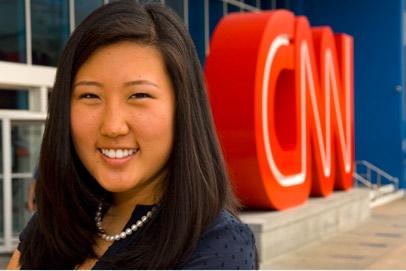
“it was the best broadcast work i’ve seen from a student in my more than twenty-plus years of teaching college, and the fact that Cnn used the work exactly as she wrote and produced it
u s news 2010 ranks emory graduate schools U.S. News & World Report’s “america’s Best graduate Schools” ranks as no. 2 the Coulter Department of Biomedical engineering; african history, 8th; social psychology, 9th; law, 20th; business, 22nd; medicine, 22nd; english, 26th; history/political science, 28th; psychology, 36th.
proves that,” says kris Wilson, a senior lecturer in the journalism program.
The video highlights emory’s efforts to maintain more than half its campus as green space, to motivate students to reduce personal energy consumption, and to host farmers markets and create educational gardens—as well as its intention to extend this environmental awareness beyond the campus gates to the broader community.
“i loved how president Wagner said he hopes we lose our designation as the campus with the most LeeDcertified buildings—that we don’t want to just be a leader, we are trying to be an example,” archer says.
For archer, who has known she wanted to be a journalist since serving as editor of her elementary school newspaper, the documentary is another step toward her career goal of becoming a broadcast journalist and producer. She’s also proud that plans are in the works to show her video to incoming classes at orientation.—M.J.L.
islamic law expert an-na’im is 2009 Carnegie scholar Human rights scholar and activist abdullahi ahmed an-na’im of the School of Law has been named a Carnegie Scholar. anna’im, an expert on islamic law and international human rights, is working on the project “enhancing Citizenship: american Muslims and american Secularism.”
happens.”—M.J.L.
O XFO r D Bi OLO gy p r OF e SSO r e loise Carter i S BOTH
T ea CH er an D F ie LD g U i D e
Field Botany, in which students investigate the native plants of the Piedmont region of Georgia with Professor of Biology Eloise Carter, is one of Oxford College’s most popular courses.
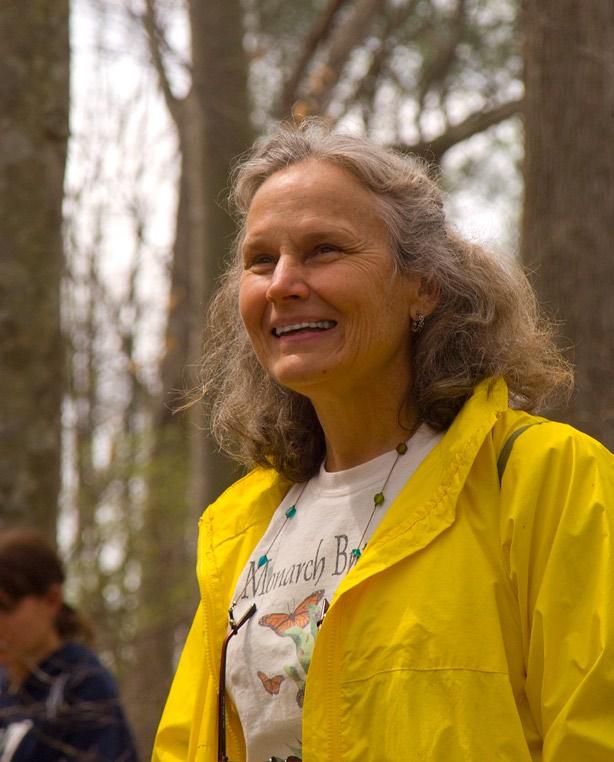
“Together we closely observe this world, learning how to read the characteristics of plants in the diverse habitats of field, outcrop, forest, and urban swamp,” says Carter, who teaches the class each spring semester.
And Carter’s students often continue their explorations long after leaving Georgia’s oaks and redbuds behind, crediting their former professor with setting them on the path to science careers.
Nick Pyenson 00Ox 02C, a paleo biologist who has done field research in Africa, New Zealand, Europe, and the Pacific coast, says his experiences at Oxford—and especially in Carter’s course—“taught me that science happens both inside the classroom and outside. It all goes back to learning my trees and wading through streams in Newton County.”
Pyenson studies the evolution of four-limbed animals that have made the transition from living on land to living in the sea. “For example, sea turtles, seals, sea cows, and whales are all different groups of animals whose ancestors once lived on land,” says Pyenson, a research fellow in the department of zoology at the University of British Columbia. “I’m interested in what the fossil record can tell us about any common causes and consequences.”
SUMM er 2009
Carter, who has taught more than two decades of Oxford students, says the opportunity for hands-on research is crucial, as is a smaller class size: she never accepts more students in a science class than can fit into a lab (around twentyfour). Biology majors must take part in peer research teams and develop independent projects.
Oxford Associate Professor of Biology Nitya Jacob restructured the introductory biology curriculum a few years ago with input from Carter and other colleagues. Faculty
Brownley receives humanities award goodrich C. White professor of english and Winship Distinguished research professor Martine Watson Brownley has received the 2009 governor’s award in the Humanities for her work as the founding director of emory’s Bill and Carol Fox Center for Humanistic inquiry.
mentoring, she says, has proven results. “Students are exposed to the process and rigor of research by participating in a faculty research project,” she says. “Several have gone on to present their work at the meeting of the Association of Southeastern Biologists.”
Catherine Young 00Ox 02C, an entomologist, says she was “pretty much headed for a career in biology from birth,” but that Oxford nurtured this with its smaller classes and emphasis on field research: “My roommate/lab partner and I often
emory leads consortium in national Children’s study a center headed by emory was awarded $28.5 million in a second wave of federal funding for the national Children’s Study, which will examine the effects of environmental influences on the health and development of 100,000 american children, from before birth to age
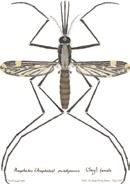
borrowed collecting equipment on weekends to see what was living in the Oxhouse pond, or did Gram stains of random environmental samples.”

Young has combined her talent in art with her zest for science through projects such as watercolor illustrations of the mosquito species she studies. “I’m interested in the beautiful and fascinating world of loathsome, bloodsucking creatures,” she jokes.
Colin Russell 99Ox 01C planned to become a physician until he took Carter’s classes. “Eloise is a fabulous and inspiring teacher,” says Russell, who studies viruses at the University of Cambridge. “She was the first person to give me a shot at research, working on a previously undescribed caterpillar that lives on rock outcrops in eastern Georgia. By that time, I was convinced that I wanted to be a scientist.”—M.J.L.
To listen to an interview with Professor Eloise Carter at Oxhouse Science Center, go to: http://realaudio.service.emory.edu/ ramgen/NEWS/Carter.mp3.
Two of emory’s libraries are contributing items to a national exhibition showcasing Biblical illustrations, which will come to the Michael C. Carlos Museum in the fall.
Scripture for the eyes: Bible illustration in netherlandish prints of the Sixteenth Century is the first major exhibition to explore the form, function, and meaning of printed Biblical images produced in the sixteenth-century Low Countries.
The show will run through September at the Museum of Biblical art (MOBia) in new york before coming to emory October 17 to January 24, 2010. The antwerp polyglot Bible, published in the sixteenth
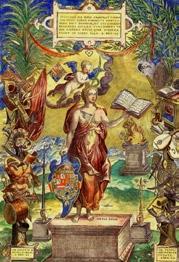
century by Christopher plantin, one of the greatest early printers, is perhaps the most significant item loaned by emory, says Walter Melion, asa griggs Candler professor of art History and cocurator of the exhibit. The antwerp Bible was published in several different languages, printed side by side.
“We have one of the most beautiful copies,” says Melion. “it’s a grand folio book, so it’s very large. and several of the volumes have exquisite pictorial title pages.”
pitts Theology Library contributed five of the eight volumes comprising the antwerp Bible.

John august Swanson’s art, featured on the cover of this issue, speaks of celebration and transformation, religious parables and spiritual self-discovery. Swanson, who lives in Los angeles, spoke at emory in March about the myriad inspirations for the brilliant paintings and original prints that grace the walls of emory’s Candler School of Theology, the Center for ethics, and Cannon Chapel. Candler holds the largest collection of Swanson’s works—some thirty-eight pieces in all. Swanson’s art also is found in the collections of the Smithsonian institution, the vatican Museums’ Collection of Modern religious art, the Tate gallery, and the Bibliothèque nationale, among others.
“The rich colors, glorious skies, lively landscapes, and fascinating people depicted in Swanson’s art reflect both the beautifully divine yet often quite mundane character of everyday life—for us as well as for those in Bible stories we have heard so often,” says Candler Dean Jan Love. “We experience them anew when we encounter these vibrant, gripping pieces of art.”—M.J.L.
To see a video on Swanson’s art, visit www.emory.edu/magazine.
supporting veterans through education emory will participate in the veterans administration’s yellow ribbon gi education enhancement program beginning in the 2010–2011 academic year. Last year, the University financially assisted fifty-four veterans enrolled in undergraduate, graduate, and professional programs.
Helen Mayberg, professor in the departments of psychiatry and behavioral sciences and neurology at the School of Medicine, will be named to the Dorothy C. Fuqua Chair of psychiatric neuroimaging and Therapeutics with a $2 million endowment from the J. B. Fuqua family.
Put on some music and invite a rambunctious two-year-old to dance and you’ll likely get an unabashed show. But an intriguing transition occurs between the ages of two and three, says Philippe Rochat, professor of psychology. Three-year-olds are more likely to hesitate before moving to the music. Those who dance may blush—especially if someone laughs at the performance.

“The fear of social rejection is the mother of all fears,” Rochat says. “It’s a very powerful phenomenon—I think it’s probably even stronger than the drive for sex. It helps define us as a species, and it cuts across all cultures.”
Rochat’s latest book, Others in Mind: The Origins of SelfConsciousness, draws on nearly two decades of research into infant and child developmental psychology, integrating scientific findings with his personal and professional intuition about why we behave the way we do.
The need for affiliation has long been recognized as an inherent human trait. Rochat argues that this basic need fuels a fear of rejection and a struggle for recognition that is central to cognitive psychology.
“The worst thing that can happen,” Rochat says, “is to have a feeling of being transparent—the invisible man.”—Carol
Clark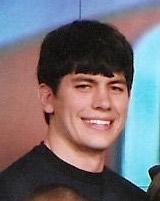
To read about Rochat’s book The infant’s World , visit www.emory. edu/EMORY_MAGAZINE/spring2006/babies_know.htm.
Watching Jeopardy! with his family as a kid in alabama, eric Betts 09C never imagined he’d place second in the Jeopardy! College Championship, winning $50,000. “This is the single biggest thing that’s happened to me,” Betts says. “i feel lucky.”
Betts catapulted to the final round of the competition, which aired in mid-May, after he answered a Jeopardy! question on the origin of the word “deadline” in the semifinals round correctly: “Before its use in journalism, it meant a boundary beyond which straying prisoners would be shot.”
Betts enjoyed support from family and local trivia-playing friends. To prepare for the show, he studied content from state capitals to vice presidents. “now,” he says, “i have all this trivia in my brain and nowhere to use it.”—Tania Dowdy
no Barrier to erosion: aBC’s Good Morning America interviewed environmental studies faculty member anthony martin on how climate change has affected Jekyll island.
science and Faith: “Many of america’s most contentious social and political debates involve clashes between science and religious belief integrating ethical and social context into the fabric of science education will enrich those debates and make them more productive—and, ideally, result in fewer citizens who are permanently alienated from science,” wrote arri eisen, senior lecturer in biology, in a coauthored essay on “Teaching Science, with Faith in Mind” for the Chronicle of Higher Education
problem solving: pat marsteller, director of the emory College Center for Science education, spoke with georgia public Broadcasting about teaching students science using problem-based learning rather than the rote memorization of pedagogy past.
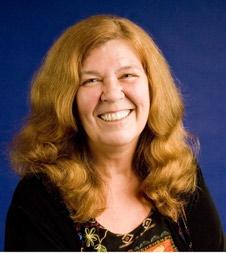
hire me, please: Cnn gave several students the opportunity to give a “30-Second pitch” directly to viewers about why they would be a great hire. Kyle Wilson 09C, travis levius 09C, najah Woodby 09C, and pradeep pramanik 09C were interviewed during emory’s Commencement.
Customer service: Business professor Charlie goetz, who specializes in entrepreneurship and small business, spoke with both npr and Cnn in april about the reasons some businesses survive and even thrive during a recession.
Credit Due?: USA Today quoted Dorot professor of Jewish Studies Deborah lipstadt in a profile of a new book that details previously unknown efforts by president Franklin Delano roosevelt to find havens for european Jews in the 1930s leading up to the Holocaust. “This is consensuschanging,” she said. “He may deserve a lot more credit than he is getting.”
new party, old habits: emory political scientist randall strahan told USA Today that it is a mistake to believe that Senator arlen Specter will help “produce a solid filibuster-proof majority in the Senate that will support all the initiatives of the administration.”
those Who Can: an associated press story about the record number of graduates joining teach for america noted emory as one of the program’s top feeder schools.
When Jonas Robitscher Professor of Law John Witte Jr. was a young boy in Ontario, the minister of his church banished a single mother and her child from the congregation with these words from the Bible: “Bastards have no place in this assembly of the Lord; even to the tenth generation none of his descendents may enter here.”
Witte remembers being shocked by this action. “How could the church banish this little baby and withhold from him the sacrament of baptism? Was fornication so much worse a sin against the Decalogue than the sins of lying, stealing, or dishonoring parents—all of which were already on my ample roll of youthful follies? Perhaps I was next out the door,” he recounts in his twenty-third book, published this year by Cambridge University Press, The Sins of the Fathers: The Law and Theology of Illegitimacy Reconsidered. “Even worse, what would come of my little fosterbrother, Robert, given his illegitimate birth? Surely he would be banished soon, too. I remember being terrified.”
The decision, however, proved to be controversial within the church even then, Witte says. The minister soon left, and with him went the “stark discipline and dark sermons that marked his troubled tenure.”
No doubt a young Witte felt relief that Robert, or “Ponkie,” as the Witte family called him, remained welcome— although it took several more years before the church baptized him, and the Ontario authorities never allowed the family to adopt him. Despite Robert’s abandonment by his biological parents and severe handicaps that took his life by age sixteen, he was the “best model I have ever seen of the pure faith and simple joy that become the true Christian life,” Witte writes.

Witte, director of Emory’s Center for the Study of Law and Religion and McDonald Distinguished Professor of Christianity, was left with the seed of an idea that became The Sins of the Fathers.

For nearly two millennia, posits Witte, religious and secular laws have wrongly judged illegitimate children by the sexual impropriety of their parents. Traditionally, any child born out of lawful wedlock was deemed a bastard: the product of fornication, adultery, concubinage, incest, prostitution, or other sexual “crime and sin.”
Historically, “a bastard was at once a child of no one and a child of everyone—born without name and without home, the perennial object of both pity and scorn, charity and abuse, romance and ribaldry,” writes Witte. “For many centuries, bastards lived in a sort of legal limbo . assuming they escaped the not-so-uncommon historical practice of being secretly smothered or exposed upon birth.”
Early rabbis and church fathers, however, worked to incorporate these children into their communities, Witte says, and commanded everyone to care for
them with the help of local synagogues and churches. Later, medieval and early modern church and state hardened their stance against illegitimate children, offering them few remedies: the standing to sue their parents for support, the option of entering a monastic order, and the slender possibility of legitimization or adoption. The English common law was even firmer, as Henry VIII found out in his futile attempt to legitimize his “bastard son” to be his successor to the throne. Under English common law, a child was either born in marriage and was legitimate or was born outside of marriage and, thus, was not. “Illegitimacy was tantamount to an immutable condition like gender or race; it could not be undone,” Witte says.
During the colonial era, England’s laws of illegitimacy were carried over into the New World. After the Revolution, Americans began to reform these laws in favor of the rights of the child, as, eventually, did much of the modern Western world. “Conservative churches today that want to resurrect the doctrine of illegitimacy might do well to remember that Jesus himself was regarded as illegitimate in his own day,” says Witte, “and was yet cherished by his parents, both human and divine.”—M.J.L.
From time to time, on both the University’s main campus and its Oxford campus, the indomitable spirit of Emory takes human form to walk amongst mortals. But each campus’s incarnation of Dooley has a distinct personality.
The tale of two Dooleys springs from a common source at Oxford, Emory’s first campus. The University’s unofficial, rather morbid mascot made his first appearances in 1899 and 1909 by writing letters to the student publication the Emory Phoenix, according to Gary Hauk, vice president and deputy to the president. From his afterlife in a science laboratory, Dooley wrote letters featuring observations on students, faculty, and society.
Lord James W. Dooley, who takes his first name and middle initial from the current University president, is represented on each campus by a student— whose identity is kept secret—dressed as a skeleton with a black cape, a black top hat, and white gloves, surrounded by bodyguards in black clothes and dark shades. While the main-campus Dooley strolls upright, black cane in hand, the Oxford manifestation creeps around, relying on a bent wooden cane—topped with a brown skull—for support.

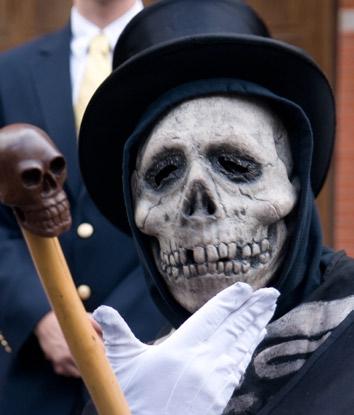
“While they look alike and have similar characteristics, they are completely different entities; both have evolved along different paths from the same source,” says Joseph Moon, Oxford’s dean of campus life.
The crouched, mysterious Oxford Dooley contrasts with the more genteel, yet carefree, Dooley at the Atlanta campus, according to Assistant Director of the Office of Student Leadership and Service Tanya Willard, who wrote her master’s thesis on Dooley.
“Oxford’s Dooley is slightly rougher around the edges. He’s definitely not as polished as the Dooley on the main campus,” Willard says.
When Dooley appears at Oxford, his original home, the focus is usually on what he might have to say to the students through his spokesperson. On a campus of 753 students, the seemingly omniscient Dooley is always up to date with—and ready to pass judgment on— the latest community news.
Oxford sophomore Emilomo Akharume 10OX is president of Oxford’s social club Dooley’s Dolls. “I remember last year when he came and he praised an Oxford student for being a positive spirit
on campus,” Akharume says. “It’s just great to see your fellow classmates get praised for being themselves and doing something that they may not think is out of the ordinary.”
But when Oxford’s Williams Hall was vandalized in the 2008 spring semester, Dooley posted a letter asking students to take responsibility for their actions and called out some suspected vandals, members of the on-campus social club Sigma Gamma, by their names.
“Common experiences and traditions help to build community, so Dooley definitely enlivens—no pun intended—the Oxford community,” Moon says.
Hauk agrees that Dooley’s role as the cloaked campus critic is stronger at Oxford, where he “has been more of a throwback, or more consistent with the earlier tradition of Dooley as a commentator on the specifics of life on campus.”
Though the main-campus Dooley is also known for his statements on current University affairs, he tends to be more energetic, approaching death with a sense of whimsy—as evidenced by the “Soulja Boy” dance Dooley performed with orientation leaders at SongFest in 2007, Willard recalls. The lively dance performance also demonstrated Dooley’s changing nature.
The Oxford and main-campus personalities of Dooley seem to have switched places over time.
“Even in the time when I first started here, the Dooley at Oxford was really playful and had a lot of personality, and the one here was very slow-moving and rigid and didn’t have a lot of personality,” says Willard, who began working at Emory in 2000.
But both Dooleys stand with one foot in the present and one set of metatarsals firmly planted in the past.
“He embodies a lot of the history at Emory,” Willard says. “But he has fairly successfully changed with the times.”
lorne mcmanigle 11C netted the singles title at the 2009 nCaa Division iii Women’s Tennis Championships. paired with michael goodwin 09C’s win in the men’s singles tournament, it marked the third time in nCaa Division iii history that the men’s and women’s individual champion has come from the same school. earlier in the week, McManigle helped the eagles take third place at the nCaa Team Championships.

In this spring’s season finale of Grey’s Anatomy, Chief of Surgery Richard Webber—in a bid to keep his chief resident from a prestigious pediatric fellowship—buys the hospital something he knows will lure Dr. Miranda Bailey back to general surgery: the da Vinci HD robotic surgical system.
“Care to take it out for a spin?” Webber asks Bailey, to her obvious delight.
On a recent May morning, a similar scene is taking place in an Emory University Hospital operating room. Associate Professor of Urology John Pattaras, director of Minimally Invasive Surgery, is prepping for two back-toback surgeries using the state-of-the-art da Vinci robot—and colleagues who will be assisting him seem every bit as captivated by the high-tech tool as the fictional doctors of Seattle Grace.
Pattaras’s first surgery of the day involves the reconstruction of a congenital blockage of a kidney (pyeloplasty); his second is the removal of a cancerous prostate (prostatectomy).
Wearing a Washington Redskins scrub cap, Pattaras makes small marks
on the patient’s stomach, indicating where the incisions will be. “Is he relaxed all the way?” he asks the anesthesiologist. He then makes four keyhole incisions, inserting a hollow cylindrical port into each.
“Bring in . . . the robot,” Pattaras intones, clearly enjoying the moment.
Surgeons from the Department of Urology use the da Vinci system frequently, averaging three to four robotic surgeries per week, with prostatectomies being the most common. Emory cardiac surgeons are performing single-vessel coronary artery bypass grafting with the da Vinci as well, and several other departments have used the robot for a variety of cases.

This morning, Pattaras is tutoring Assistant Professor of Urology Nedra Hood on the da Vinci; she will soon use the robot to correct female incontinence in her patients.
Pattaras’s team wheels over da Vinci’s large mechanical base, positioning its four interactive arms strategically over the patient’s midsection and attaching each arm to a port. The da Vinci’s arms hold an endoscopic camera and, as needed, scissors and graspers. A fourth port allows a member of the surgical team to assist manually in the operation.
As the miniature camera, which has
After making sure the da Vinci is correctly attached, a nurse dims the lights, and Elvis begins to sing “All Shook Up” from Pattaras’s Creative Zen MP 3 player in the corner. Pattaras sits down, unscrubbed, at the da Vinci’s surgical console a few feet to the left of the patient.
“The table doesn’t move after the robot is in place,” he says, reminding everyone in the room that precision is critical. And then, looking down through the console’s viewport at a magnified image of his patient’s internal pathways and organs, Pattaras begins the operation—hands moving fluidly
strange, multilegged mechanical creature straight out of a science fiction film. The color monitor above the patient’s head, however, reassuringly displays the finely tuned actions taking place within the patient’s body. The surgeon, not the robot, is in complete control.
Pattaras guides dual instruments—a scissor and a grasper—through the small quarter-inch ports, moving the intestines out of the way to allow access to the swollen left kidney, which was not draining properly. He makes careful, steady progress, pushing organs and tissue aside.
The da vinci Surgical System (yes, the name is a nod to Leonardo, who designed the first robot) was approved for select surgeries by the Food and Drug administration in 2000 and costs about $1.8 million. More than one thousand da vinci robots are now in use around the country. emory University Hospital acquired its da vinci system in 2008. Below: the surgeon sees in 3-D through a stereoscopic viewer; a depiction of the da vinci system set up for a patient.

its own light source and relays threedimensional, high-definition images to the surgeon’s console, is guided down one of the ports and into the patient’s abdomen, it produces a soft glow. The patient’s abdominal cavity is inflated with CO 2 gas to provide more space for working and viewing.
beneath the viewer, maneuvering controls that translate his actions into parallel movements by the robotic arms.
It’s an odd sight, initially, to see the robot in action, metallic arms flexing rapidly over the patient’s body. Were it not viewed in the context of a presentday OR, the da Vinci would seem to be a
He uses the scissors not only to cut but to cauterize tissue. Pressing a foot pedal can make the instruments hot enough to seal off small bleeds, an action that is often accompanied by a puff of smoke. Another foot pedal allows Pattaras to move the camera, adjusting his line of vision. By switching instruments to needle drivers on the robotic arms, he can perform the precise suturing necessary for the reconstruction.

The kidney surgery is over in a few hours. The ports are removed and Pattaras begins stitching up the patient’s four incisions. “With the da Vinci, patients heal faster, and there’s less bleeding and downtime,” he says. For instance, this surgery would have required a “shark bite” of an incision had it been performed through traditional open methods, Pattaras says, and recovery would have taken months instead of days or weeks.
“We are just at the beginning of robotic surgery,” says Pattaras, as the upbeat tempo of the B-52s’ “Love Shack” fills the room and he begins prepping his next patient.—M.J.L.
t op: Former president of mexico Vicente Fox Quesada, the keynote speaker at Commencement, told graduates that they are leaders who need to “reshape the world, to reinvent it, to bring new order and new justice, as the founding fathers of this great nation started two hundred years ago.” Fox, who received an honorary doctor of laws degree, is the founder of Centro Fox, a presidential library and research center loosely modeled on the Carter Center. scholarly collaborations are planned between Centro Fox and e mory on a range of issues, including immigration.
aB o V e right: College graduate r ajashree Chaudhury 09C stands out from the crowd.
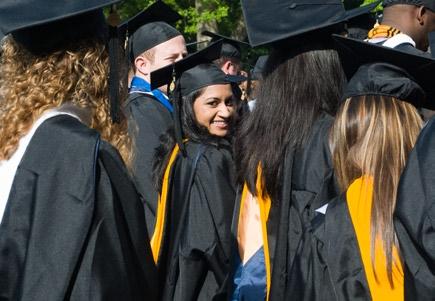
r ight: r ay DuVarney, associate professor and chair of the physics department, in his final march as the university chief marshal; l arry taulbee, associate professor of political science, will don the mantle next year.

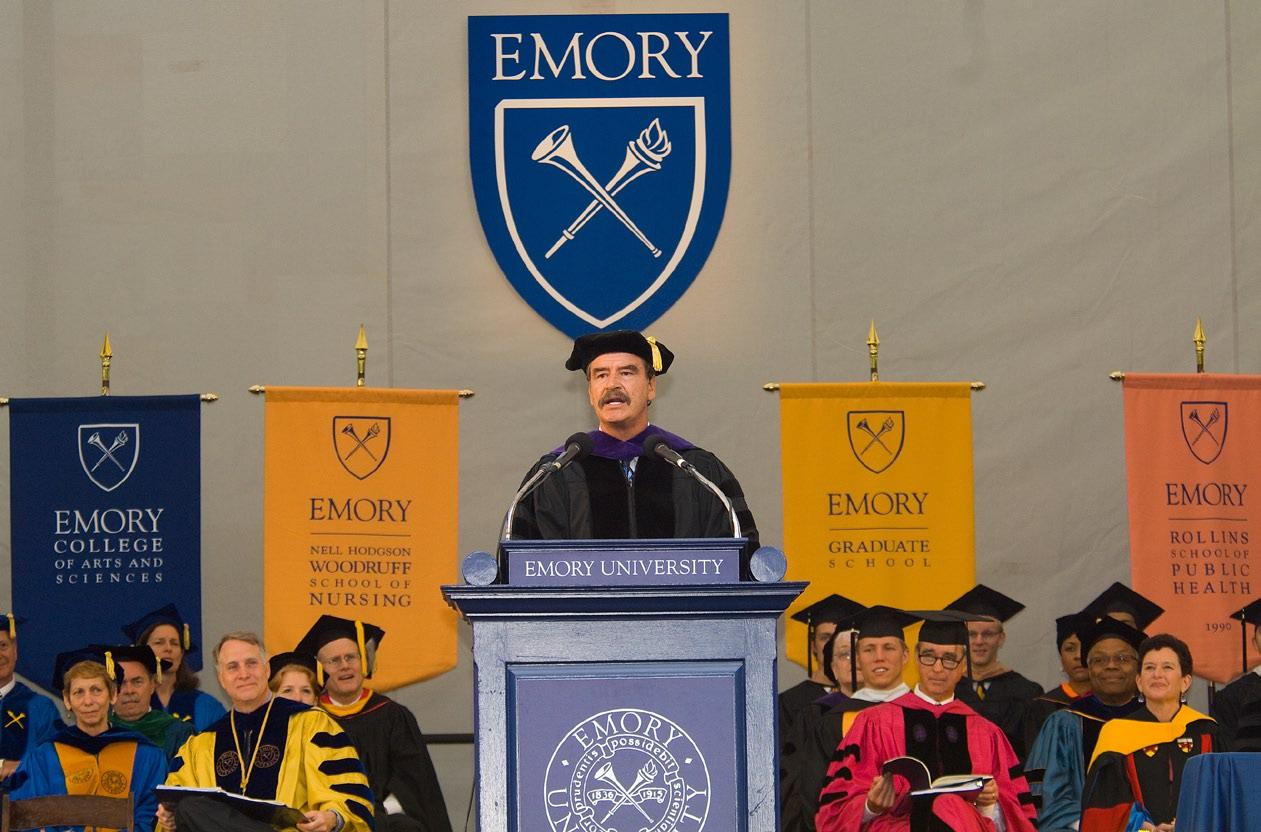
t op le F t: in keeping with tradition, bagpipers set the tone for the Commencement ceremony.
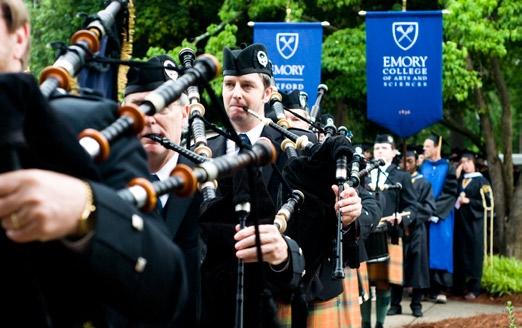
aB o V e le F t: a nine-minute shower brought out thousands of colorful umbrellas on the Quad, but the sun soon returned.
t op right: Kendall Boyd 09C of minnesota proudly carries her diploma down the aisle.
aB o V e right: a new grad practices his communication skills.
le F t: hats fly; spirits soar.
By the num B ers3,810 total 2009 graduates
3,867 total degrees awarded 43.4% male graduates
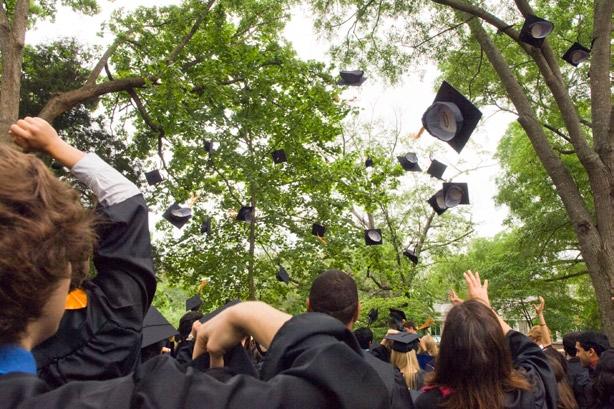

56.6% female graduates
48 states represented 78 countries represented
20 age of youngest graduate 58 age of oldest undergraduate
61 oldest degree recipient (master of divinity)
24 military service veterans graduated 3.35 average gpa of emory College graduates



11 minutes, 4 seconds vicente Fox’s Commencement address
14,000 number of chairs on the quad
9 minutes
l e F t: robert pitts 09C beat his son, William, to an e mory College diploma by just a few minutes, due to an alphabetical advantage. pitts, now fifty, enrolled at e mory in 1977, but when he was accepted to the school of medicine in his junior year, he skipped his senior year and graduation altogether. n ow a doctor in Carrollton with three sons, pitts decided to investigate obtaining his undergraduate degree when William started at e mory in 2005. i t turned out that he had adequate biology credits from medical school to qualify. pitts’s youngest son, matthew e mory pitts 09 ox , graduated from oxford this year.
Total time it rained during main ceremony
175 Commencement volunteers
3,183 frames shot by University photography
Thailand, India, Tanzania, Ethiopa, Haiti—they may not top most lists of vacation hotspots, but apparently luxury travel is not what Monique Dorsainvil 09C had in mind.
A Mellon Mays Undergraduate Fellow, she spent a summer in Thailand to study the transgender Kathoey culture. As a sophomore, she traveled to Pune, India, to volunteer with the Ashraya Initiative for Children (founded by Elizabeth Sholtys 07C). She’s traveled with the Emory Development Institute to Tanzania and Ethiopia as an intern. And last summer, she went with her thesis adviser to Haiti, the home country of her maternal grandparents.
“Emory really throws you in there and gives you mind-blowing opportunities. I’ve done things here I never dreamed of,” she says.
Those things helped earn Dorsainvil the 2009 Lucius Lamar McMullan Award, one of Emory’s highest student honors, which also comes with $20,000—no strings attached. “I am extremely grateful, thankful, and humbled all in the same breath,” says Dorsainvil, a women’s studies major and global health minor.

Dorsainvil is donating a portion of the award to the Tiana Angelique Notice Foundation, an organization founded by Sasha Smith, assistant director of the Center for Women at Emory, after the murder of her younger sister. The namesake foundation seeks to prevent domestic and intimate partner violence.
In addition to saving up for graduate school, Dorsainvil, an Emory scholar, also plans to start college savings accounts for her two younger brothers. “I believe that education is one of the
Emory’s highest student honor, the Marion Luther Brittain Award.
“When I look at the others who’ve won this award, it’s a humbling experience to be a part of that history,” says Lundy. “I’ve simply tried to be of benefit to the groups I’m involved in and to not sit back and take what I have for granted.”
The Brittain Award, which comes with $5,000, is presented each year at Commencement to a graduate who has demonstrated exemplary service to both the University and the greater community without expectation of recognition.
most liberating and enabling gifts that can be given,” says Dorsainvil. “With the education I have, I really feel like I can do anything now.”
the Dobbs Foundation for the establishment of a $300,000 endowment to award grants to members with financial need.
Lundy was cofounder and codirector of the Greeks Go Green Sustainability Initiative. By introducing competitions, film screenings, campus speakers, and educational programs involving hundreds from the Greek community, Lundy helped make them one of the key elements in the University’s strategic sustainability initiative on campus.
“Out of everything I did at Emory, I’m most proud of Greeks Go Green. It was fun, it was meaningful, and it got people involved,” Lundy says.
Greeks and jocks may have a reputation for putting partying ahead of study and service, but Nicolai Lundy 09C turned that stereotype upside down. His quiet leadership and dedication to excellence in athletics, academics, and volunteer service have earned him

Lundy served as president of Alpha Tau Omega fraternity this past year, and saw Emory’s chapter recognized as one of the three best ATO chapters out of 5,500 in North America, as well as the top chapter in the nation and at Emory. He also led an effort to generate a scholarship fund for ATO members and successfully secured a challenge grant from
As an athlete, Lundy is a four-year varsity letterman in track and field and was elected cocaptain of the team for the 2008–2009 academic year. An Emory Scholar and Phi Beta Kappa Scholar, Lundy majored in philosophy and plans to work the next two years in the nonprofit sector before pursuing degrees in medicine and/or public health.

aB o V e le F t: e ady award recipient h elen suzanne hill 09 ox with Dean of Campus life Joe moon. “h elen brings her head and heart to all she undertakes,” m oon said. aB o V e right: g raduates (front to back) tina thapor 09 ox , telani thomas 09 ox , David topping 09 ox ,
and ryan Valeriano 09 ox show off their new diplomas at oxford’s 164th commencement. oxford’s Class of 2009 was 351 members strong, and its class gift was furniture for e ast Village residence h all, a tree, and a contribution to the Class scholarship e ndowment Fund.
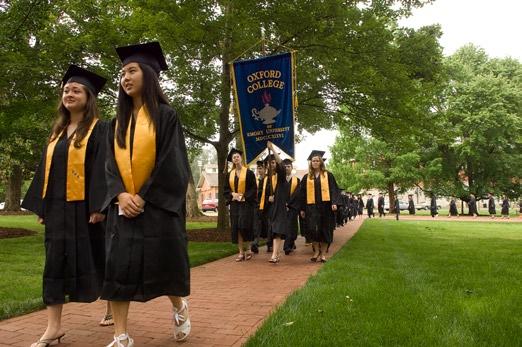
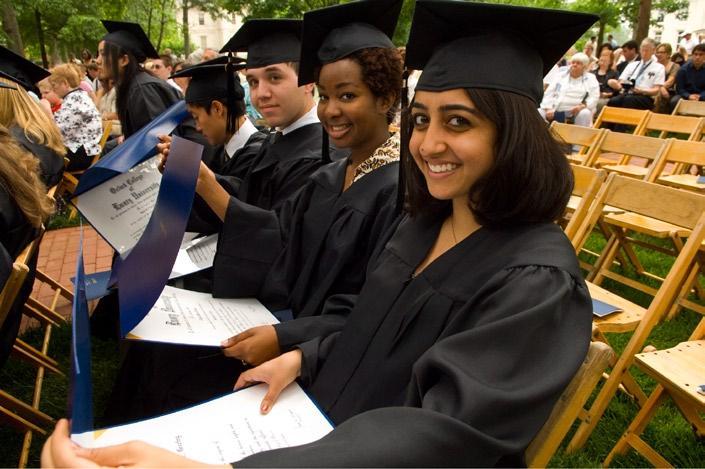

aB o V e le F t: oxford grad r achel l aney 09 ox with parents, thomas l aney 83t and robin l aney, and grandparents, Berta l aney and e mory president e meritus James l aney, who served as keynote speaker at oxford’s Commencement. “We have seen where excellence without a soul leads us,” l aney told graduates, urging them to be guided not by “self-preoccupation but by a loftier sense of purpose.”

aB o V e right: oxford’s Class of 2009 processes across the o xford quad. Dean e meritus William murdy officiated, standing in for Dean stephen Bowen, who was attending his daughter’s graduation from e arlham College.
l e F t: sga president suleman malik 09 ox processed with the bedel. also in attendance were more than forty members of Corpus Cordis aureum, alumni who graduated fifty or more years ago—the greatest number the college has had participate since the tradition began.
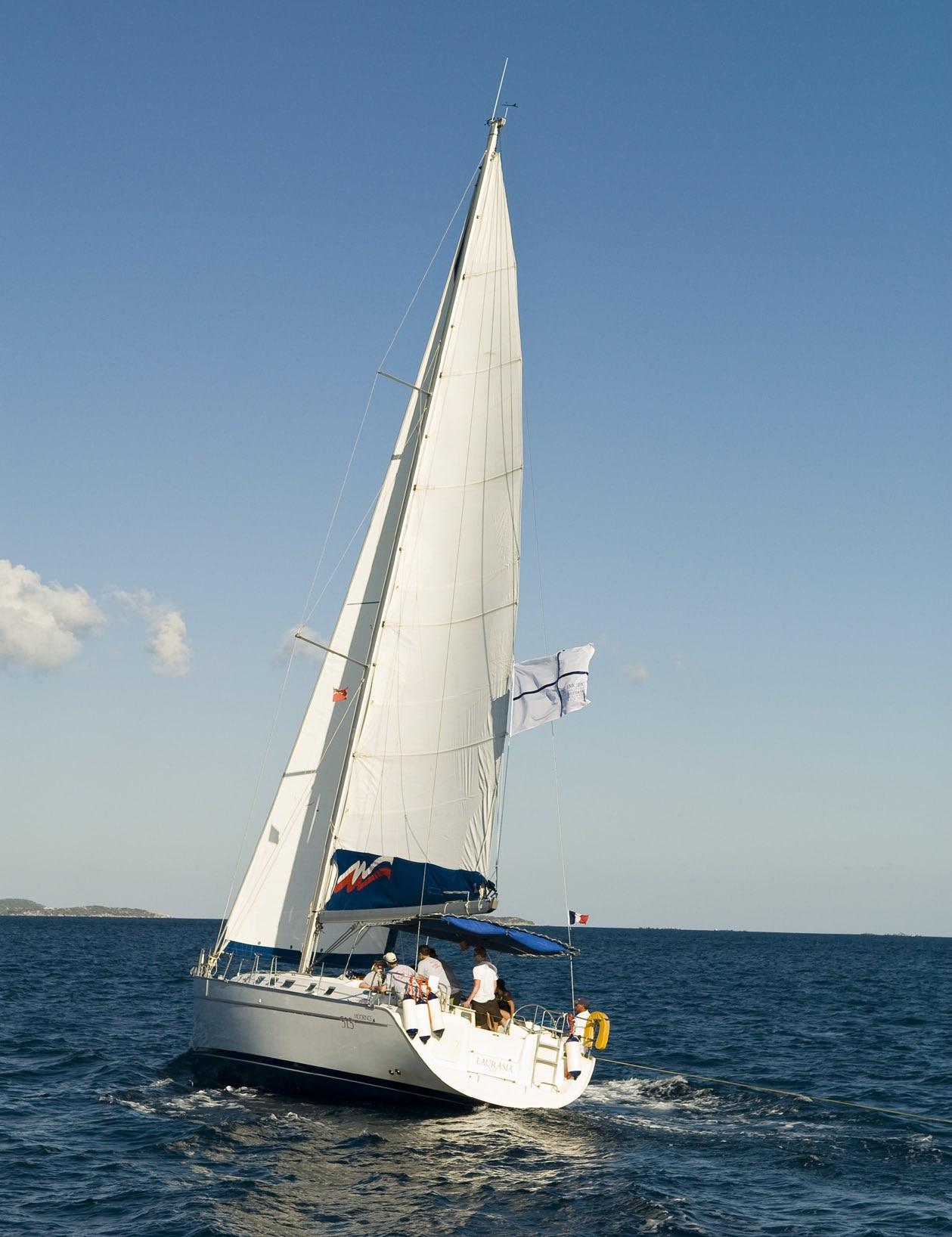 by Christopher Wang 03BBA 09MBA
by Christopher Wang 03BBA 09MBA
Our taxi driver never lifted his foot from the accelerator as we sped around Beef Island, even though the minivan shook violently from surfing deep scallops in the roadway. I’m not sure exactly when we veered from the road, but we suddenly found ourselves bouncing along a gravel path through the woods. I clenched my hand tightly around the handle in front of me until the taxi finally emerged from the dense vegetation, revealing an astounding panoramic view of the island’s southern bay.
Up ahead, our sailing instructors gathered on a heap of boulders at the edge of the path. In the luminous blue water behind them, a cluster of white sailboats swayed gently with their bows nodding up and down, as if to salute us.
The six of us leapt from the taxi and raced to find our skipper, William, who waited with his arms crossed and a dinghy’s yellow towline in hand. Aboard our assigned boat, the Laurasia, we crammed bags into cabins and stowed food and drinks wherever they would fit. I marveled at the efficient interior of the ship, a fifty-one-foot Beneteau, with every flat surface opening to reveal something different: emergency gear, the freezer, electrical switches, or even more doors.
I looked over the similarly compact sleeping quarters before clambering back on deck to begin our training. As I glanced at the island, I saw the last team to arrive unloading their gear.
The dash to board the Laurasia was the start of five days of sailing in the British Virgin Islands, the capstone activity of this year’s Goizueta Advanced Leadership Academy (GALA). The seventy-eight MBA students in GALA spent the year examining the dynamics of teamwork and learning behaviors that influence how groups interact. Isolated on sailboats for a week, we tested our ability to work together in an unfamiliar environment
Crewing the Laurasia (from left), katherine Liu 09MBa, Tyler Crain 09MBa, Christopher Wang 03BBa 09MBa, Mike kocan 09MBa, Serena Moore 09MBa, goizueta development director Jeff Colburn, paul Coloma 09MBa, and instructor William Baird.
as we tackled a series of challenges. The competition began the minute we set foot on Tortola, with students hurrying to be first to assemble their six-person crews and locate their vessels.
That a Caribbean sailing trip posed questionable academic value had served as occasional fodder for speculation among the MBA class throughout the year, but the adventure was hardly a relaxing tropical cruise. Only a few GALA participants had sailed before, and in many of the challenges, our instructors were not allowed to assist us. Placed in command of our ships, we had to organize ourselves and find ways to compensate for our sparse knowledge of sailing as we tackled the various assignments. We had to adapt to terminology that is obscure to the landlocked, a world where equipment is secured by lines and location determined on charts—don’t ever call it a map!—and even left (port) and right (starboard) are called something else. The test was not unlike what we experience in business school and what we often encounter in our professional lives; the circumstances fit squarely with the notion of dealing with situations in which information is insufficient or vague, a common theme of Goizueta’s MBA program.
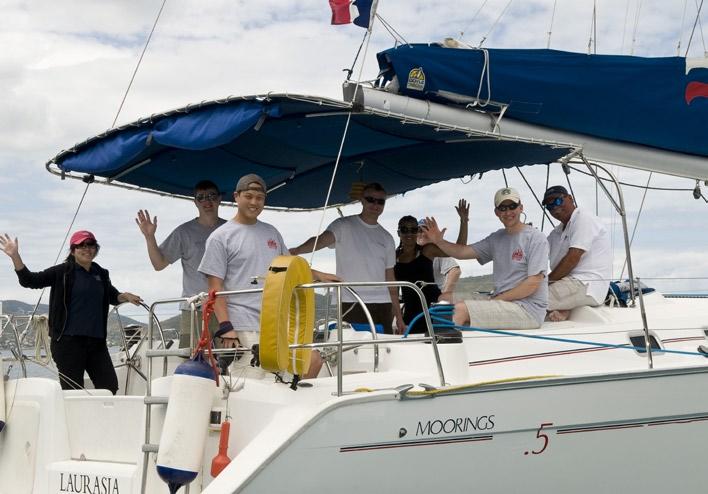
Anxiety gripped our throats as we sat quietly and waited for our hands-on training to begin that first afternoon. I looked over the web of lines spun across the boat’s deck. It had been fifteen years since I learned to sail a small Sunfish at Boy Scout camp and more than a decade since I last set foot in a sailboat. The names of components and almost everything else about sailing conveniently escaped me.
Sailboats don’t enjoy the luxury of forces like gravity pulling on a downhill slope; they require a succinct orchestration of their components to achieve and maintain speed. Even though operating sails and steering are simple actions, proper timing is critical to preserve a boat’s momentum. Two hours into our first sail, the frustration showed in our slumped shoulders as we struggled with our coordination. “That’s what you want,” William barked, pointing at a boat with full sails tacking gracefully in front of us. “You want to be sailing pretty.” A moment later he called for a starboard tack and turned the ship, but the jib, still trimmed to the windward side, inverted itself and brought the boat to a halt.
Eventually we managed a handful of crisp maneuvers and ended the day on a positive note as the sun made its colorful descent to the horizon. I felt encouraged by our progress, but wondered if we’d have a comparable performance the next day. After we anchored, the facilitator accompanying our team, Jeff Colburn, asked us to voice some thoughts about our first time sailing together, but few of us had the energy to speak. Exhausted from a long day of traveling, we anticipated a hot meal and a peaceful night in the secluded bay.
We rose the next day energized and anxious about the first race of the trip, which involved circling several small islands and then sailing to the finish line at Anegada. It was arguably the toughest challenge we would face: Not only did we need to sail in circles—a mildly difficult maneuver
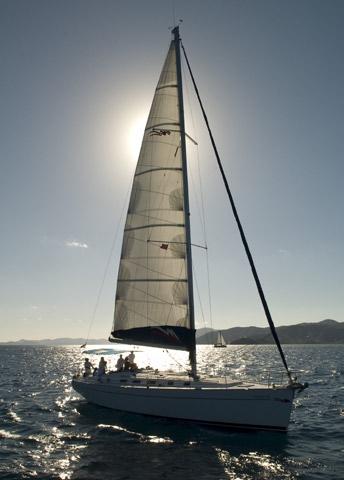

that we had not yet practiced—our skipper was not allowed to help us during the race. Without William guiding us, everyone needed to contribute whatever knowledge he managed to absorb in our crash course the day before. The lack of a defined leader
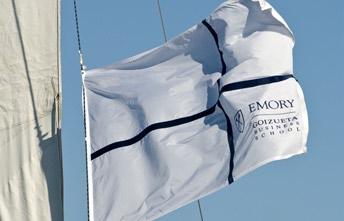
meant we faced the thorny dichotomy of being both leaders and listeners. Whatever energy we began the day with dissipated quickly when a mechanical problem kept us from starting the race on time. A sense of defeat lingered over the crew as we watched our rivals fade into the distance. Rounding the first of the Dog Islands, however, we passed a boat from our fleet zigzagging aimlessly and another sitting motionless, its sails flapping noisily in the strong easterly wind. Although we suffered a rough beginning, we sailed increasingly
well as we circled two more islands and then turned north to Anegada, the boat keeling sharply until water spilled onto the leeward deck. Later that day, we made the bittersweet discovery that we
had sailed from last place to second, missing first by just four minutes.

With a less technically demanding challenge before us, the third day felt somewhat anticlimactic. Paired with another ship from the fleet, we were racing to put as much latitudinal distance between us as possible before finishing at a cove near Jost Van Dyke. Our linear path of travel meant little maneuvering and thus a leisurely day aboard the Laurasia, with a restriction on talking compounding the idleness. In silence we sailed ten miles into the blue nothingness northwest of Anegada before returning south on a downwind course
over roiling swells that pitched our boat in every direction.
Despite turning in the day’s strongest performance, we were disqualified because our partner vessel, Mythos, used its motor to power through rough waters from a passing storm. For a while we dwelled on the disappointing result, but the six of us eventually stole away in the dinghy to explore our surroundings.
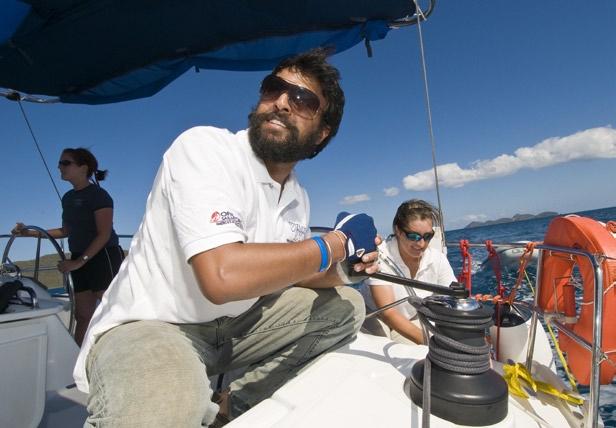
Beyond a nearby outcropping we found a shallow cove shielded by a wall
The scene on the water was comical during the fourth day’s challenge: The fleet slowly circled the bay barking Morse code at each other through plastic horns like a flock of lost geese. Our objective was to relay a series of messages to their correct recipients, with the added complications of our vessels being renamed and restrictions on radio communication. Unable to speak directly with each other, we used frenzied hand gestures and horns to trade information before heading to our destination, Peter Island. We sailed through turbulent waves, the ocean spraying us as we slammed into each rising swell. As we neared Peter Island, we convened with the rest of the fleet before parading single file through the island’s picturesque bay.
At three o’clock the next morning, I flipped on the cabin lights and started a pot of coffee the crew would certainly need for the final leg of our voyage. A light rain began to fall outside as we readied the boat in almost total darkness. A half hour later, we raised anchor for the last time and slipped away into the predawn mist on a return course to Tortola.
of rocks battling the sea and waded into knee-deep water. The day’s debacle faded from my mind as I listened to ferocious waves exploding against the rocks and watched the sky fill with shades of orange.
Strong winds came racing from the east the morning of day four, beating the waters around Jost Van Dyke into rough waves that slapped at the Laurasia’s hull. Mike and I made our way to the mast to put in a second reef, which shortens the main sail to provide better control of the boat. Our crew seemed to have found its rhythm that morning, with everyone promptly rising to the deck and picking up whatever tasks needed to be done.
The dark face of Tortola slowly morphed into silhouettes of sailboats as the sun crept higher behind the island. From behind the wheel I thought about how our crew had evolved during the trip and felt immensely proud that we overcame our anxieties and learned to run the boat independently in a handful of days. I had no doubt that what we experienced with regard to communication and collaboration would prove invaluable, and many of those situations lingered in my head for weeks afterward.
Reunited with our classmates in Tortola, we couldn’t help but assign ourselves one last challenge: finding a time to return together to the Caribbean’s pristine waters.
 Top: Shaun Caldwell 09MBa drives the Tanis Marie while prasanth ramani 09MBa and Darren pham 09MBa prepare to lower anchor. above: aboard the Spindrift III, Meredith Swartz 09MBa mans the helm as alok gupta 09MBa checks the jib sail for proper trimming. although most of the students had never sailed before, the crews were on their own after just a few hours of instruction.
Top: Shaun Caldwell 09MBa drives the Tanis Marie while prasanth ramani 09MBa and Darren pham 09MBa prepare to lower anchor. above: aboard the Spindrift III, Meredith Swartz 09MBa mans the helm as alok gupta 09MBa checks the jib sail for proper trimming. although most of the students had never sailed before, the crews were on their own after just a few hours of instruction.
FFifty years ago, Floyd Watkins, Candler Professor of American Literature, went to Mississippi in search of William Faulkner. That trip, and Watkins’s study of the writer, was the beginning of an Emory tradition now a half-century old. Each autumn, a group of Southern literature students and their professor set out for Faulkner country—Oxford, Mississippi—to see Rowan Oak, Faulkner’s home, and its environs. As an Emory graduate student in English, I partici-
pated in one of these excursions in the 1970s; several alumni have told me that they, too, remember traveling with Watkins on these trips.
Professor Watkins and I subsequently interviewed Faulkner’s nephew James M. Faulkner extensively and later published these interviews. James (Jimmy) Faulkner knew his uncle well. Jimmy’s father, John Faulkner, William’s brother, dropped Jimmy off at Will Faulkner’s house when he had to go out of town.
Jimmy thus spent many weekends with his uncle and knew details about Faulkner’s life, such as what he ate for breakfast (eggs, bacon, toast, orange marmalade, and coffee). He recalled, as well, what Faulkner said to Jimmy when Faulkner won the Nobel Prize. Jimmy went to see him and offered his congratulations. His uncle replied, “Fine, thank you. Let’s go hunting.” Jimmy also said William—or “Brother Will”—gave him advice on many matters. For example,

he said, “Anytime you can trade money for pleasure, do it.” Will also gave a blank check to Jimmy and said, “If you ever need to, cash it.”
This Emory literary pilgrimage to Faulkner country, now in almost its fiftieth year, takes us to see the places and people of Faulkner’s stories and novels.
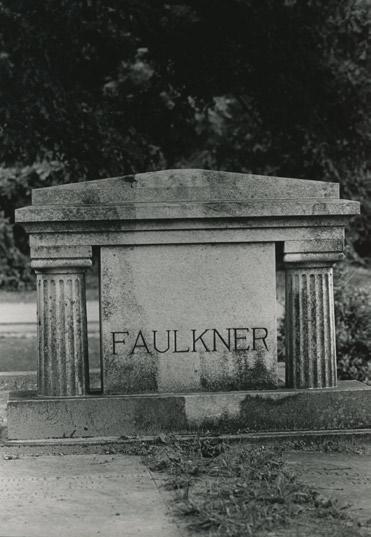
I begin the planning process with a call to Meg Faulkner DuChaine, Jimmy’s daughter and William’s great-niece, to arrange a time to visit. This task is challenging because she is a busy paralegal and also shows horses in the show ring in Memphis, Tennessee. Even that equestrian activity that keeps her so busy is essentially Faulknerian: she inherited a love of horses and horseback riding from her Nobel Laureate great-uncle.
When all preparations and reservations are complete, the students, and sometimes alumni, and I load into rented vans and take off on a Friday morning for a weekend. We seek Southern landscapes and people, complete with a little Elvis and plenty of Faulkner.
Our first taste of the South begins with lunch at the Golden Rule barbecue restaurant in Birmingham, Alabama. We stop at Elvis Presley’s two-room, shotgun-style birth home in Tupelo, Mississippi, for a look at a songwriter’s modest Southern roots. The birth home is distinct from the expansiveness of Graceland. This simple, wood-frame house and museum offer much information about Elvis’s early years as a boy in Tupelo; his introduction to music at home, in church, and in the bluegrass and jazz nightclubs of Memphis; and his rise to fame.
Then we wade into Faulkner territory. Our first stop is the home of Meg and her husband, John. I met Meg in the 1970s on one of the early trips we made
to Oxford. After Jimmy Faulkner’s death in 2001, I asked Meg to host our annual trip as her father had done for many years. Meg now gives Emory students the impressive tour her father gave but adds her own female Faulkner voice and perspective to the visit.
A young woman when I first began trips to Oxford, Meg was present as her father regaled classes of students with stories of Faulkner’s life and times. Seemingly shy then, Meg did not appear to be listening hard to her father’s stories. She was listening intently, however, as it turns out, and I discovered this fact
as she led our tour for the first time and gave verbatim accounts of her dad’s stories. Meg and John welcome Emory students to their pre-Civil War home and share family stories about their famous great-uncle. They display and discuss the family heirlooms that belonged to William Faulkner, including his hunting rifles and bird-dog whistle; pocket watches of his father, grandfather, and great-grandfather; the family Bible and genealogy; and sailing equipment from Faulkner’s sailboat, the Ringdove. We see a first edition of The Sound and the Fury, autographed to Nan and Jim Faulkner, and other signed first editions dedicated to Faulkner’s brothers and their wives. Meg shows us the fabric book jacket handmade by William Faulkner’s mother, Maud Butler Faulkner, to cover the signed first edition of The Sound and the Fury, which Meg now owns. She also leads us on a tour of Faulkner’s home,
which he named Rowan Oak, built by the same architect who built her home. Both are antebellum structures with long histories.
The tour continues. We look for ways to see and understand sites in town and around the county that Faulkner wrote about in his stories. Rowan Oak is a vital part of the visit. Now on the National Historic Register, Rowan Oak has a curator, and more than a hundred thousand visitors a year walk the cedar-lined drive and enter the doorway to see the sights, including the library, where Faulkner sat to read; his manual typewriter; and the famous walls of the bedroom on which Faulkner outlined his novel A Fable and where he stacked draft copies of each chapter. The backyard reveals the old kitchen, separated from the main house in the old days to keep the heat of cooking away from the main sleeping quarters. Faulkner’s riding stables
‘Oh my G O d, the d OO r is ajar!’
A few brazen students slipped past me and onto the front yard. Then one yelled to the rest of the group,Left, William Faulkner’s office at rowan Oak, his home in Oxford, Mississippi. right, Faulkner’s grave.
are also there, and an old cabin built of hand-hewn logs. The current kitchen, indoors, still boasts a fireplace and mantel with wine bottles used in former times. Faulkner liked to cook game over the open fire and use the wine for basting. All give us a sense of what Faulkner’s domestic life was like and how that life was reflected in his stories and novels.
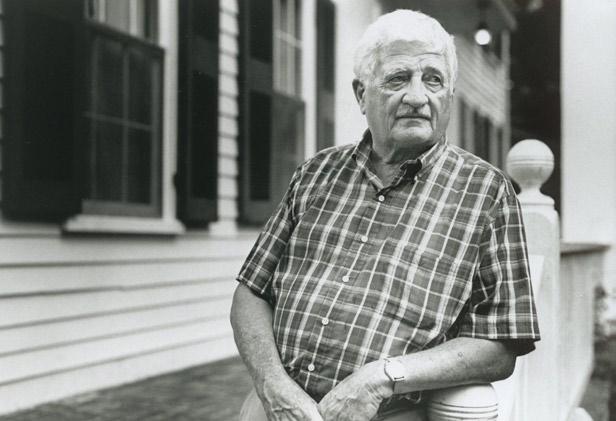

We see also some of the other antebellum houses in town, such as Shadowlawn (also known as the Neilson-Culley House), which many believe Faulkner used as a model for his famous story “A Rose for Emily.” We visit, too, the Chandler House, which Faulkner apparently had in mind in writing The Sound and the Fury. I like to take students to see this home twice in one visit—during daylight hours, but also at midnight, to show them what the huge home looks like in moonlight and shadow. On the night of one particular visit, the sky was very dark, and the atmosphere especially eerie in the almost-green light of a lunar eclipse. I asked the students to stay on the sidewalk and away from the grand, looming house, since the current owners of the home were clearly at home.
In defiance of my instructions, however, a few brazen students slipped past me and onto the front yard. Then one yelled to the rest of the group, “Oh my God, the door is ajar!” Peering carefully, eyes adjusting to the dark, I eventually could see that the door was not ajar, but the shadows cast by the luminescent evening made the black door, framed against the white house, appear mysteriously open. The once fearless students gasped in fright, “What if the ghosts of Caddy and Benjy appear in the doorway?” I scolded them first for disobeying, but later noted their imaginative interpolation of The Sound and the Fury
We visit St. Peter’s Episcopal Cemetery, where the Faulkner family members are buried, and we pay our respects at the grave of William Faulkner and his wife, Estelle. We visit the grave of Mammy Callie, Faulkner’s beloved mammy and mentor, depicted in The Sound and the Fury. When Mammy Callie died, Faulkner delivered her eulogy and lovingly dedicated his novel Go Down, Moses to her. Other graves in this cemetery are noteworthy, including those of Faulkner’s parents and other relatives, such as “Auntee” (Faulkner’s paternal aunt), who some believe was the model for Granny Millard in The Unvanquished; and Sallie Murry, a cousin and one of the plausible models for Caddy Compson, the heroine of Faulkner’s most famous novel. Augustus Baldwin Longstreet, famous author of Georgia Scenes and former president of Emory, and Lucius Quintus Cincinnatus Lamar 1845C, Emory College graduate, lawyer, statesman, and United States Supreme Court justice, also rest in this cemetery.
Trekking deeper into the county, we observe an old, weathered, never
painted, wooden home with an upstairs balustrade and features reminiscent of those portrayed by Faulkner in his novel Absalom, Absalom! Other more impressive structures of this kind are already returned to dust; the one we see is the only one remaining in the county. We see Yellow Leaf Creek, which Faulkner renamed White Leaf Creek, and we note the seemingly endless miles of pine and oak forest in the northwest corner of the county that characterize the hundred square miles of wildernesses of Absalom, Absalom! and the dense woods of Go Down, Moses
The Yocona River is next on our list. The original name of the river was “Yocanapatafa,” although two variant historical spellings include “Yockeny Petafa” and “Yockny Pattafan.” Faulkner

transmutes them into the name of his mythical county: “Yoknapatawpha.” We cross the river at an old bridge, a likely source for the place where the Bundren family crossed the river in As I Lay Dying, as they proceeded on their long journey to bury their mother. We see the tree-lined landscape where Jimmy Faulkner’s great-grandmother Harkins hid her livestock from Yankee soldiers. Faulkner chronicles a similar story in his novel The Unvanquished.
A dogtrot house is also on our list of places to visit. Few structures of this kind remain in the county. The dogtrot house, a common dwelling in the nineteenthcentury South, has two rooms separated by an open passageway—through which a dog could trot from the front yard straight to the back. Faulkner describes this style house in several novels: It was dusk. He emerged from the bottom and looked up the slope of his meager and sorry corn and saw it— the paintless two room cabin with an open hallway between and a lean-to kitchen which was just like the one he had been born in which had not belonged to his father either, and just like the one he would die in, if he died indoors. (The Hamlet)
At times, we have been privileged to meet townspeople with family names that Faulkner wrote about. Once we met a living Bundren—the name that appears in Faulkner’s novel As I Lay Dying. We talked to this forty-yearold man about his family home in the southeast part of the county and reveled
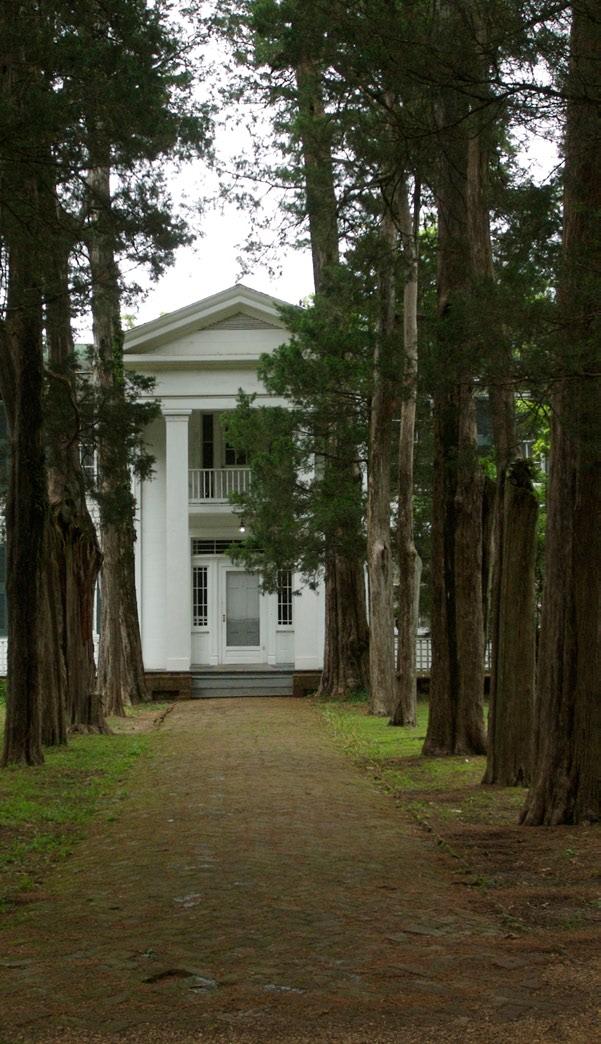
in his pure accent and good stories. Another time, we met Motee Daniels, who was reputedly Faulkner’s bootlegger and who regaled us with tall tales about the author.
We travel next to the College Hill Presbyterian Church, where Faulkner married his childhood sweetheart, Estelle Oldham Franklin. Previously she was married to Cornell Franklin, with whom she had two children; she married Faulkner after her divorce. Faulkner depicts aspects of their wedding in his novel Absalom, Absalom! The church also bears clear evidence of slavery—the bricks were handmade by slave labor. We pay our respects, too, at both the white cemetery in the back of the church and the slave cemetery nearby with mostly unmarked graves, a residual reminder of a segregated past.
The town bookstore, Square Books, is the place to look for Faulkner editions and other Southern literature titles, and we spend time there admiring and sifting through books, including signed copies of famous works. We view Faulkner manuscripts in the archives of the University of Mississippi. Then the group dines on fried, broiled, or blackened catfish at a down-home country restaurant known as Taylor Grocery, a landmark steeped in lore with walls plastered with mementos of the past.
Much of what Faulkner knew of his surroundings is now deteriorated or almost gone. But through our class preparations, studied observations, examination of his home, and opportunities to hear relatives and townspeople tell their recollections of the great writer, Faulkner’s time and place breathe life once again.
Sally Wolff-King 79G 83PhD is assistant vice president and adjunct professor of English.Elvis is on Twitter.

The iconic King of Rock, who died in 1977, nevertheless has thousands of followers who micro-blog about “listening to the King on the way to the Elvis festival in Tupelo” and how Elvis is “shaking things up in Vegas at the licensing expo.” He also has official MySpace, Facebook, and Bebo pages (and many more unofficial ones).
Elvis has been a trendsetter since he first rocked America in 1954, so his solid gold status on social media sites isn’t really surprising, says Kevin Kern, director of public relations for Elvis Presley Enterprises. “He’s still very much an influence in popular culture, from Elvis night on American Idol to YouTube videos and iPhone apps for Elvis sightings,” Kern says, sitting in a plush conference room at Graceland’s corporate offices. “Nobody was like Elvis. He changed the world in terms of a musical revolution but also in terms of a sexual revolution and a fashion revolution.”
The relatively modest Graceland estate, off Elvis Presley Boulevard in a well-worn section of Memphis, still draws more than six hundred thousand visitors a year. The annual candlelight vigil the night before August 16—the
day of Elvis’s death—attracts nearly fifty thousand. “So many people walk by, we have to resod the grass around the grave afterward,” Kern says. Audio tours are available in eight languages.
Despite a light drizzle on this June afternoon, a line of tourists is waiting to walk through Elvis’s home, his car museum, and his private jet, the Lisa Marie, which is parked beside the Graceland shops, where you can get your photo taken with a life-sized Elvis likeness and sample his favorite fried peanut butter and banana sandwiches.
According to Forbes Magazine, Elvis was the top-earning dead celebrity in 2008 for the second year in a row. “Without so much as lifting a finger, the Memphis Flash earned a whopping $52 million in the last year,” writes reporter Peter Hoy. “The thirtieth anniversary of Elvis’s death helped boost attendance and merchandise sales at Graceland, and new ventures such as an Elvis Sirius Satellite Radio show add to a long list of publishing and licensing deals.”
Licensing deals such as the one that allowed Michael Feder 91MBA to create the Amazon bestseller, Elvis: Your Personal Fashion Consultant. The “Punch Out and Play” book features full-length photos of Elvis that can become free-
standing paper dolls—with captions such as “Making the world a better place, one purple double-breasted suit at a time.” It retails for $12.95 and is available through Graceland’s shopelvis.com.

“It’s a very different book and has been quite popular,” Kern says. “It’s interactive in the sense that you can pop out the various Elvi in different states of fashion.” (Yes, apparently, Elvi—plural for Elvis—is a word that’s used at Graceland.)
Most of the archival images in the book are from Elvis movies, such as Jailhouse Rock and Blue Hawaii, and Feder’s wife, Karan, a Hollywood costume designer, painstakingly colorized the black and white images, pixel by pixel.
Michael and Karan, who now live in Nevada, eloped to Vegas in 1994 and were married at the Graceland Wedding Chapel there. “The Graceland Chapel now carries our Elvis book,” he says, “so it all comes around.”
Feder, who guest-lectures at Goizueta Business School, launched his company, Fame Farm, in 2005, when he acquired
From fashion to Facebook, Elvis Presley still leads the way to Graceland • by Mary J. Loftus
exclusive rights to the image and brand of Liberace. He and Karan produced their first book, Liberace: Your Personal Fashion Consultant, through Abrams of New York in 2008.
“We wanted to show that Liberace was cool, funny, and kitschy, and could attract a whole new generation of fans,” he says.
After consulting with sales reps, they decided the second in the series should feature Elvis. “I adore the brand,” Feder says. “Liberace’s fan base was older, but Elvis’s was young and rabid during his day. I used to live in Memphis and drove by Graceland all the time when he was living there. I was hoping when I turned sixteen he’d buy me a Cadillac. But I never had an Elvis encounter.”
Everything in the book had to be approved by Elvis Presley Enterprises, says Feder, from the photos to the captions. “Anything with Elvis has to be very carefully done,” Feder says. “The fans know if a sideburn is too long, and they will write Graceland.”
Elvis: Your Personal Fashion Consultant is in its first printing of fifteen thousand copies and has already achieved “top-selling Elvis book” status on Amazon.

Feder recently launched a third “Punch Out and Play” book of Star Wars figures and is working on a fourth on Marilyn Monroe.
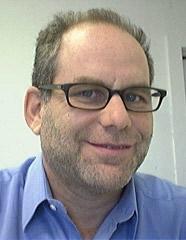
“It’s extremely difficult to predict who will become an iconic celebrity, except in hindsight,” Feder says. “Will Michael Jackson become as iconic as Elvis? We might not have thought so six months ago, but recent events have shown how fast the landscape can change.”
Elvis Presley Enterprises generates income from two main areas: Graceland tours and licensing deals. About 250 licensees offer more than five thousand products made in the King’s image, from wine bottles to M&M figurines to a clothing line.“Elvis had a unique fashion sense,” says Kern. “He knew what looked good on him.”
In evidence everywhere at Graceland is Elvis’s singular style: his white jumpsuits and cowboy hats, form-fitting black leather and gold lamé suit—several of the outfits featured in the Feders’ book.
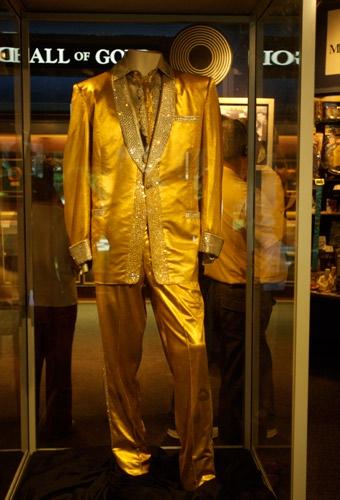

Well before his flashy stage outfits (most of which, like his gold lamé suit, were designed by Hollywood tailor Nudie Cohn), the young Elvis had a sense of style that he couldn’t afford to indulge quite yet. “He hung out on Beale Street back in the day, which was a blues alley then, but it was also where he bought his clothes,” says Kern.
One day he walked up to the Lansky Brothers’ family-owned clothing shop. As Bernard Lansky recalls, “I looked up and saw this young man looking at our displays in the window. I walked outside to greet him and told him ‘Come on in and let me show you around.’ He said, ‘I don’t have any money, Mr. Lansky, but when I get rich, I’m going to buy you out.’ I told him, ‘Don’t buy me out, just
buy from me!’ ” Lansky remembers the first outfit he custom-fit for Elvis: the tux for his junior/senior prom. After Elvis became a millionaire in his early twenties, he was true to his word, and the Lanskys custom-made most of his casual clothing for decades.
While the Lansky Brothers main shop has moved to the lobby of the Peabody Hotel in downtown Memphis, the store’s close association with Elvis remains: photographs of Elvis and Bernard Lansky can be found on every wall, Elvis memorabilia is plentiful, and sweaters just like the one Elvis wore in Blue Hawaii are arranged neatly on a table. Julie Lansky, who works in the store, and her twin, Melisa (who recently married Steven Weisman 98C), as well as their cousin, Rebecca Belz 08B, are the next generation of Lanskys. “My grandfather is the best,” says Belz. “He has stories and one-liners for every situation. He once took my mom to Graceland to deliver some clothes, and my mom was scared to death because there was a stuffed alligator on [Elvis’s] couch.”
An aged but spry Bernard Lansky is still a familiar fixture in the store, helping customers find the right size or color. He sometimes has fan encounters of his own with customers who want to hear insider stories. “Is this you?” asks one visitor— pointing to a poster of a young, bow-tied Lansky standing in his original store beside an equally young Elvis.
Lansky, standing among racks of dress shirts and suit jackets, just smiles and gives a quick nod—gratified to have been, for many years, Elvis’s personal fashion consultant.
Shirtless and barefoot, wearing a pair of running shorts, I sit in darkness so complete that I cannot see my fingers in front of my face. Heat more intense than any Atlanta August afternoon envelops me; sweat pours down my face and arms and off my elbows like water from a faucet. In this thick atmosphere I wonder whether I can tolerate the claustrophobia for more than ten minutes. So far I have been sitting here, Indian-style, maybe two. The schedule calls for two hours.
“Here” is a small sweat lodge in a field a hundred yards from the Tongue River, on the Northern Cheyenne reservation in Montana. Shaped like an igloo, some four feet high at its center and no more than ten feet in diameter, the sturdy, willow-frame structure is draped by thick layers of canvas and tarpaulins staked to the ground to keep the light out and the heat in. On this sun-filled May morning I have crawled into this artificial cave on
hands and knees along with four other men and five women to participate in a ritual of the Native American Church.
Seven of us are from Emory, neophytes unbaptized into these mysteries, on a Journey program sponsored by the Office of Religious Life. The other three are brothers of indeterminate middle age from the Medicine Bull family, members of the Northern Cheyenne nation and college-educated teachers. This morning they are our priests, as it were, our expert guides through two hours of prayer, burning of herbs, chanting, ablutions, and alternating periods of darkness and light. And much sweating.
In these circumstances—heat, blindness, close confinement with others—I become conscious of two competing claims on my attention. First is my awareness of my own state of being— my breathing; the sweat dripping off my chin to my chest; the condition of my soul. It has been seven years since my last journey to “Indian country,”
and that last journey preceded by two months the death of my sixteen-yearold son, Thomas. In the past week, since our group landed in Billings, his spirit has been as fiercely present to me as an old shaman.
I am also aware of the others in the darkness with me, friends with whom I’ve made this pilgrimage. Students, alumni, and staff members, we have spent six days meeting with professionals in the Indian Health Service and the Bureau of Indian Affairs (BIA), law enforcement officers, and Indian artists, educators, and legislators. We have aimed to understand the different cultures that mix and overlap and sometimes clash here.
One of the great paradoxes of Native American life in the twenty-first century, especially as that life is lived out on the reservations of the American West, is that tribal affiliation is as much as ever a source of pride and rooted personhood, while the realities of the twenty-first

century-American economy can dramatically erode the individual’s connection to that source.
On the reservations in this part of Montana, for instance, unemployment ranges as high as 60 to 65 percent, according to the BIA. The solution to this problem has proven elusive for more than a century. Initially the federal government proposed simply eliminating the problem by stamping out Indians’ sense of “Indianness,” through programs that encouraged assimilation. In this way, it was thought, the bane of unemployment would vanish along with an outmoded way of life.
Of course, Native Americans were not eager to give up so much. During the past forty years the resistance stirred by the American Indian Movement, the growing awareness of whites about injustice to Native Americans, and the recognition of tribal sovereignty by the federal government all have reaffirmed the power and value of the tribe.
Inside the sweat lodge I feel that power and value coming through the chanted prayers of Burt Medicine Bull and his brothers. During one of the periods of light, as the door flap is raised and water is passed clockwise (always clockwise) around the circle, Burt invites us each, in turn, to “express yourself”—say what deep need or calling moves us—and then, when darkness falls again with the door flap, to offer a prayer as he and his brothers chant in Cheyenne.
I cannot make out the words of the prayers being offered but only hear that prayers are being said, as the Cheyenne chants on top of the prayers—male voices, “hey-yo han’na,” gourd rattles— transform the prayers into an ancient appeal from the depth of the heart that blends with the darkness around us.
The Native American Church and other forms of spiritual discipline clearly ground tribal members with internal strength and eternal verities. Many Crow and Cheyenne are Roman Catholics but bring a kind of syncretism to their worship, drawing on traditional icons and
imagery: eagle-feather crucifixes; images of Madonna and Child as Indian mother and baby; a medicine wheel in the center of the cross. Our ritual in the sweat lodge itself has elements of baptism and other symbols of death, descent, and resurrection. Such resources of spiritual strength are vital to people facing the stark challenges of their world.
In southeastern Montana the scarcity of employment remains a hard fact, for young Native Americans especially. How they resolve the difficulty may affect their connection to family, tribe, and land. According to Curtis Brien, a Crow and a health educator for the Indian Health Service, the only job crying out to be filled is that of nurse. The modern IHS facility where he works has some
What would it mean to educate people so that they could, themselves, generate jobs, build structures of opportunity where none existed, and exercise a creativity that extends to the creation of livelihoods, forging of communities, and flourishing in a land that does not easily yield its bounty? Some Emory graduates surely operate outside traditional structures of work and institutional life. But in general, “Trailblazing 101” has yet to make it into the curriculum.
The tribes have both the freedom and the burden of figuring out for themselves the political economy that will work best for them. For the Crow and Cheyenne in this part of the world, their large tracts of southeastern Montana real estate are both an obstacle and a boon. Unlike
twenty nursing positions unfilled. Doctors also are needed to address the health problems that seem to afflict Native Americans disproportionately: obesity, hypertension, diabetes, alcoholism, and drug addiction.
Unless they have a career in health care in mind, however, young men and women have little incentive to leave the reservation for education if they want to return to live among their tribe; the rez offers few jobs for engineers, lawyers, accountants, computer programmers, or biologists. Teachers will have some opportunities. The rest will make their way with low-paying work or crime.
This harsh reality prompted a discussion during one of our group’s daily reflection sessions—really a challenge to Emory’s vision of “working for positive transformation in the world.” For middle-class students preparing for jobs in cities like Atlanta, where structures of work already exist, that phrase really means “doing good while doing well.”
their eastern or southwestern cousins (the Wampanoag and Mohawk in New England, for example, or the Apache and Pueblo in Arizona and New Mexico), these northern Plains tribes inhabit less populous areas that make it difficult to create tribal wealth—and jobs—with casinos. On the other hand, their land is rich in minerals, especially coal and coal-bed methane.
As happens so often, however, forces in the larger culture work against the Indian: in an age that seeks to be green, the natural resources on the rez are suddenly less clean and less desirable than alternatives like solar and wind power. Potential investors in mining coal and gas have been slow to step forward. Although Montana has begun to test the possibility of harvesting wind for power (it is the fifth-windiest state in the country), so far none of the seven reservations in Montana has been able to forge an alliance with any of the utility companies supplying electricity to the state.
The very concept of tribal identity sometimes raises conundrums, especially in regard to proposals for economic development.
The very concept of tribal identity sometimes raises conundrums, especially in regard to proposals for economic development. Jo’etta Plumage-Buckhouse, a Gros Ventre Sioux who works as an archaeologist for the BIA, told us that the question of how, or even whether, to develop a tribe’s natural resources sometimes cannot be resolved by the tribe itself. For instance, some members of the Northern Cheyenne tribe believe that the coal and gas beneath their ranches and towns should be harvested for the well-being of the tribe; others believe that the tribe holds the sacred land in trust and should not exploit it simply because America wants energy. While a new generation of tribal leaders might help find the way forward, for now the question stands at an impasse.
Further complexity abounds in Indian country—a term used by both Native Americans and whites to describe not only a geography but also a state of mind. As Michael Elliott, an associate professor of English at Emory, recounts in Custerology (University of Chicago, 2007), nothing underscores that complexity so breathtakingly as the site of one of America’s most famous battles, the so-called “Custer’s Last Stand,” more properly referred to as the Battle of the Little Bighorn. Our group of journeyers spent a full and arduous day on that battlefield with an expert guide, a former history teacher named Steve Adelson, who for twenty years has brought groups to this terrain at the western edge of the Crow reservation.
Elliott recounts the history of how that battle has been interpreted and, often, manipulated for various ends by whites and Indians both. Just as interesting is the continuing friction among the five tribes who rode on opposite sides on that hot June day in 1876. The Crow, who scouted for Custer, were rewarded for their friendship with the United States by being awarded the largest reservation in Montana, including the battlefield (except for two small parcels managed by
the National Park Service). Abutting the Crow reservation to the east—and only a fifth as large for a population about half the size of the Crow—is the Northern Cheyenne reservation, home of those who killed Custer.

The Crow will say, however, that their rez represents only a minuscule portion of the land that “was always our homeland,” according to Lawrence Flatlip, a Crow artist and oral historian. Flatlip’s presentation to our group, on the first evening in our dormitory at Montana State University-Billings, included a map that showed ancient Crow territory extending across most of what is now Montana, into northern Wyoming, and north into Canada. (In fact the first reservation for the Crow established by treaty comprised some 33 million acres, compared to today’s reservation of about 2.2 million acres.) Some Crow historians also say, as Flatlip did, that the reason for the Crows’
working with the U.S. Army was that in 1825 the tribe signed what was called “the Friendship Treaty,” a document whose title and commitments the Crow took more seriously than the whites.
Little question remains that the betrayal of political promises and the murder of leaders has left room for lasting bitterness. In the circle of the sweat lodge, however, we are invited to know each other as human beings, not as ethnic beings divided by history. Larry Medicine Bull, in prelude to his prayer, reveals that his twenty-four-year-old daughter has died within the past week, leaving a child behind. The brothers also have recently lost a sister. No causes are mentioned, no details given, only the most basic fact, that here are men joined in grief. As the door flap descends and light changes to dark, the brothers chant their grief, and I find myself humming wordlessly in unison with them.
“In this life,” Whiteman says, “we are all related. You are not here by accident, just as Sitting Bull did not come here by accident. It was meant to happen this way.”
At the end of our sweat, we pilgrims crawl out of the lodge and drape ourselves in lawn chairs or across mats strewn outside as we recover; the enervation of the experience has left us physically drained and emotionally spent. We still have one more pilgrim’s journey to make on this last day of our trip, however. After cooling off and driving half an hour to the town of Lame Deer, we refuel with lunch in the tiny café of Chief Dull Knife College (the Cheyenne tribal college), and then we set out for our destination four miles north of town.
The sandstone monolith called Deer Medicine Rocks rises from the valley floor along Rosebud Creek. In this valley Sitting Bull, Crazy Horse, and an estimated fifteen thousand Sioux and Cheyenne men, women, and children, along with their twenty-eight thousand horses, paused for perhaps a week before moving to the banks of the Little Bighorn and the fated meeting with Custer— “fated” because Sitting Bull himself had seen a vision of soldiers “coming down like grasshoppers,” tumbling headfirst into his camp, their hats falling off, their ears missing because they refused to use them and listen.

The site now is part of the ranch run by Jack Bailey, whose family has owned this land since 1883. A courtly gentleman who speaks with equal pride about his grandparents and his grandchildren, Bailey represents a critical generation in the preservation of this land. He invites us to this space as if to a corner of the Vatican. He and his family take seriously their stewardship of this sacred place and are working with a private trust to see to the long-term preservation of the site.
Bailey has brought his friend Phillip Whiteman to interpret the signs on the rock. A chief of the Northern Cheyenne Council of Forty-Four, traditional dancer, and horse trainer, Whiteman has led us in our vehicles from Bailey’s ranch house up the half-mile dirt track to the monolith. Thirty yards from the Deer Medicine Rocks, he kneels to clear a small circle of dirt in which he burns his “tobacco offering”—half of a cigarette that he lights and puffs on to get it burning well, then sets in the middle of the bare patch of earth. As he does so, the wind picks up and brings cooling relief from the hot sun overhead.
Standing with us at the base of the rocks, Bailey points across the valley to the small log cabin that his grandparents built in 1883. At the time, he says, the sundance pole used by Sitting Bull still stood about a hundred yards from the cabin.
Before us the rock face rises up and away at a slight angle, thirty to forty feet. Spread across it are petroglyphs, some of them predating Sitting Bull by hundreds of years. As Whiteman speaks, he interprets the carvings from right to left, and from bottom to top, at odds with our Western way of reading. Here we see a jagged blue scar from an ancient lightning strike running from the top of the largest rock to the ground. The streak runs through the carving of a deer, which, with the nearby image of a medicine man, gives the rocks their name.
“In this life,” Whiteman says, “we are all related. All of life travels within a circle. Everything is connected within
that circle and eventually comes back around. In my tradition we call that circle the Medicine Wheel. You are not here by accident, just as Sitting Bull did not come here by accident. It was meant to happen this way.”
The way it happened for Sitting Bull was that when he found these rocks, he fulfilled his promise to Wakan’ Tanka, the Great Spirit, that in return for a vision he would sacrifice “a scarlet blanket” of his own blood and dance the sun dance. To prepare for the sun dance, Sitting Bull sat still and prayed while his brother cut fifty small pieces of flesh from each of Sitting Bull’s arms using an awl and a razor-sharp knife. With blood flowing from these wounds, Sitting Bull danced before the sun dance pole from noon, through the night, and until noon the next day, when he was laid out to receive his vision.
Within a day of carving onto the rocks the stick figures of Sitting Bull’s vision, the great camp of Indians moved on, leaving petroglyph messages for anyone who came after and an unmistakable trail to the Little Bighorn. The next week Custer and the Seventh Cavalry arrived at the Deer Medicine Rocks, where Arikara scouts interpreted the foreboding signs. Custer had no ears for their warning but followed the trail to destiny.
Leaving the Bailey ranch for the long drive back to Billings and a night’s rest before flying home, I ponder those carved images of men falling to their doom because they would not hear. The Emory motto, Cor prudentis possidebit scientiam, is the first half of Proverbs 18:15 and is usually translated, “The wise heart seeks knowledge.” The other half of the verse reads, “The ears of the wise seek it out.” We are wise to use our ears, but I wonder what we are not hearing.
I do know that my ears seemed most acute as I sat in the dark of the sweat lodge, listening closely to the sound of my breathing and to the presence of those men and women who, for centuries, found their way to the same sacred circle.
WhenJoni Mitchell decided on a great escape in the mid-1970s, she tacked a fancy name onto it befitting her evolving iconoclast image: hejira. The story is that she drove from the eastern United States to the West with no license, a somewhat tenuous grasp of the rules of the road, and that blonde head in those famous clouds of hers as she contemplated another self-destructing romance.
Enviable art results from nearly everything she does, and no less so with the recording that followed once she had showered off the dust. Mitchell has given us few photographic images of her on the albums— instead, she settled into a pattern of providing painted self-portraits (some with cats, all with tongue in cheek). Which is why the Hejira album is so arresting, especially in an era before Photoshop.
A road runs straight through Mitchell, who is stunning in a black cloak with her windswept hair and the ubiquitous cigarette. The wind machine never worked so hard; bohemianism may have no higher expression; and Mitchell made it so difficult for the rest of us to undertake a great escape on lesser terms.
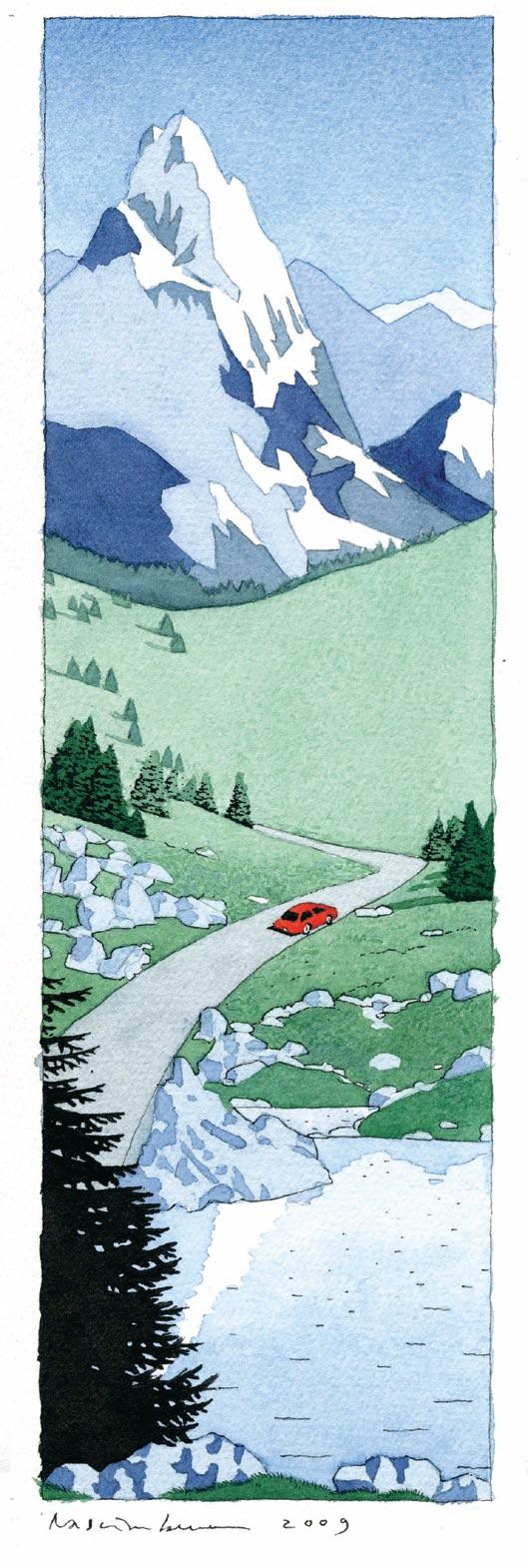
One can argue that Mitchell’s career has been fueled by these comings and goings, by the allure of being a “hitcher” on the “free, free way,” as she describes herself in the song “Coyote.” It is certainly no accident that, in summing
up the work of her career on a twodisc set in 2002, she settled on the title Travelogue. Unlike Hejira, Travelogue did not produce any photographs of the young, lithesome Mitchell in a sundress holding a forearm up against the blazing desert sun. But damned if she didn’t again travel unforgettably, this time a startling number of miles back across a brilliant career.
Knowing that the glamour odds and gods surely would be against me, knowing that I can hardly remember how to hold a cigarette (one wisely gives those up, Joni) and that a wind machine is of little use for hair that is about three inches from root to tip, I nonetheless got out of the office chair that is my prison and took my own version of a hejira. And I decided, my own tongue firmly in cheek, to make Mitchell the heart of my quest.
How she became thus, I am still not sure. Like the rest of you, I curl my lip with contempt at those wayward souls who scramble over the front gates of David Letterman’s residence or try to tackle Sharon Stone coming out of the grocery store. I assured myself that Mitchell was a metaphorical destination, that if she was at the top of a lonely mountain peak strumming her guitar (something that having had polio as a child makes increasingly difficult), I might huff and puff my way to the top, only to head back down the other side without so much as a glance in her direction. The journey is the thing.
Illustration by Yan Nascimbene by Susan Carini 04gSmile all you want, I had this situation under control, despite having grown to love her music in a way that surprises even me. For I have lived most of my life in the world of books and was happy to claim that world, to any doubters, as the sole source of all wisdom. When I died, I long ago decided, a friend or family member would read someone’s funny, profound words to hasten me on my way. Music was something you turned on while bored in a car.
How, then, did Mitchell enter the pantheon of this literary snob? One-word answer: story. Consider the scores of brilliant stories she tells us in such songs as “Furry Sings the Blues,” about the world of W. C. Handy; “Edith and the Kingpin,” about a drug lord and the woman he enslaves; or “Shades of Scarlett Conquering” about—hell, I don’t know what it is about, actually, but the storytelling is magnificent, with its twice-repeated final line, “A woman must have everything.”
A woman must indeed have everything or, at the very least, a big bite of that pie. And so I bit, with my fiftieth birthday looming like a billboard on the highway of my life. As I did so, I was keenly aware of the great escape my father made at roughly this same age.
He began an affair that, after five years of back and forth with my too-gracious mother, ended in divorce. Although the family car never landed with finality on empty (my mother, sister, and I patched ourselves back together), it also would never again register “full.” I was ever so conscious of not wanting to make that kind of journey, of tripping into selfishness and ego.
But do not mistake me: I understand something of what he felt, of wanting to peel back the layers of age and mortgage payments and responsibilities. It was no accident that, as we reached our end with him, he increasingly was holding up the newspaper between us. Any shield, however flimsy, will do for the battle-weary.
Okay, so now the impetus for my travel—what Mitchell described as the “urge for going” in an early song—was coming from two dubious sources: an aging rock star and my adultererfather. But why couldn’t I, as Mitchell described it in “Amelia,” “sleep on the strange pillows of my wanderlust”?
Ultimately, I decided that I would travel to Banff in Alberta, Canada, to see a ballet—The Fiddle and the Drum—on which Mitchell collaborated. It began with a giddy romp through Canadian Ticketmaster (I did, in fact, get the last ticket) and progressed to my tidy, new black suitcase in the foyer as I awaited the cab that would take me to the airport.
Before I left, I deliberately launched trial balloons of irresponsibility. “I may never come back,” I told family, friends, and coworkers alike. No one budged. Their disbelief was as powerful as an onion sandwich. Did no one get this urge-forgoing thing and the fact that it had made a new woman of me?
The temperatures in western Canada were lovely—cool. And I tried to be similarly cool as I counseled myself that Mitchell probably would not be at the performance—that although she had been at early performances, a superstar has better things to do than see the same ballet over and over.
The hired limousine driver got me there early, so I loitered in the lobby, casting a scornful editor’s eye on the typo in Mitchell’s statement in the program (Yeats spelled “Yates”). I tried to act as if it were somehow natural for a workaholic from the southeastern U.S. to be standing alone in the somewhat shabby Eric Harvie theater, her Pakistani driver waiting outside, himself probably nervous about the intentions of the large caribou that we passed a block earlier.
A dancer in street clothes was in the lobby explaining to his parents that “Joni will be here,” that she had been working with the dancers for several weeks. Having proof in that program of the way words are twisted, I thought: “Joni” and “here” could mean a lot of things. It could mean that she is backstage or at a hotel nearby or in my limo, for that matter. Responsibly tamping down my expectations, I took my seat in the auditorium.
But she was there, and there came a moment at the end when my hard-won seat became a goldmine. As we stood applauding the ballet in the dark, three figures glided past us holding hands: the artistic director, the set designer, and Mitchell. As she passed seat B2, my spot in the universe at that exact moment, she smiled at someone who greeted her. The smile was that of a twenty-five-year-old, not the nearly sixty-fiveyear-old grandmother that she is. As my friend Nancy said when we emailed about the moment later, “I can picture her exactly as you describe, and it is no surprise that she is youngold and wise-weird and altogether fascinating.”
Mitchell participated in a question-and-answer session. Several brilliant questions formed, then stuck in my throat. I could talk about my home in Atlanta, close to the Savannah that she charmingly describes in “Blue Motel Room” (“Here in Savannah/it’s pouring rain/palm trees in the porch light stick like cellophane”).
Or I could reveal that I already have stipulated in my will that songs of hers will be played at my funeral. (“Hejira” and “Refuge of the Roads.” Nobody better read from any boring book.) I could ask her about this crazy rumor that she writes the music first and then all those glorious words second. I could ask about the long-awaited autobiography. I could . . .
Get back in my limousine. Go quietly. I am, after all, not a stalker. Instead, I am—or, better, now have become—“a hitcher, a prisoner of the fine white lines of the free, free way.”
nd so I bit, with my fiftieth birthday looming like a billboard on the highway of my life.

this spring I attended an event honoring the nearly eleven thousand alumni and friends who have given to Emory each year for at least the past twenty-five years. together they have raised more than $42 million. their status as consecutive donors earns them entry into the Judson C. Ward Consecutive Giving society, named for Emory’s beloved “Jake” Ward 33C 36G, who has an eighty-year relationship with the University that includes at least forty-one years of consecutive gifts. I say “at least” because Emory has only been keeping records for fortyone years, and Dr. Ward’s generosity is as great as his spirit.
the commitment of donors like Jake Ward is unwavering. Despite a difficult economy, Emory alumni and friends are as dedicated to supporting the University as ever and are finding countless creative ways to do so. as you’ll read in the story at right, anyone can be a philanthropist. I urge you to follow your heart with a gift to Emory. there has never been a better time.
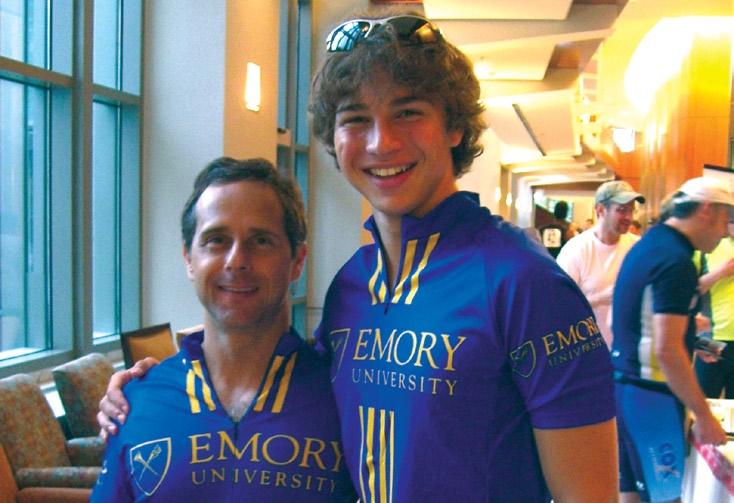
Philanthropist. The word conjures images of multimillion-dollar gifts, Woodruff and Candler, Buffett and Gates. But the word translates from the Greek as “to love people,” and anyone can be a philanthropist, from the student who makes her first $25 class gift to the former Emory patient who makes an estate gift to honor his physician.
“The challenge for all of us who care about Emory and the world is to find the intersection between our own commitments and the University’s strengths,” says President James W. Wagner. “What do we want to accomplish with philanthropy? Emory can be a powerful means for us to fulfill those aspirations.”
Since Campaign Emory began in September 2005, nearly sixty-six thousand alumni and friends have invested in the University, supporting everything from scholarships and medical research to construction projects, academic programs, professorships, and information technology. Remarkably, 87 percent of those donors made gifts of less than $1,000 each; 43 percent gave less than $100 each.
susan Cruse, senior Vice President, Development and alumni relations$928 Campaign Progress MILLION

TOTAL GOAL $1.6 BILLION
www.campaign.emory.edu
“The impact of those gifts is enormous, resulting in nearly $9 million in support for Emory so far. It’s gratifying to see donors realizing important life goals through philanthropy,” says Susan Cruse, Emory’s senior vice president for development and alumni relations.
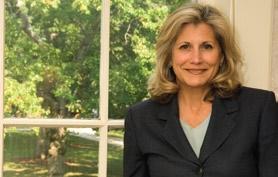
Lane Frostbaum 86C 89L and his son, Cameron, thirteen, combined their love for cycling with their interest in fighting AIDS by riding two hundred miles across Georgia this spring to raise money for the Emory Vaccine Center. This is the third year that the elder Frostbaum has participated in the annual two-day bike ride, called the AIDS Vaccine 200 (AV200). In 2007 and 2008, he raised more than $5,000 for the center. This year he and his son generated another $2,000.
The AV200 is one of the vaccine center’s principal sources of unrestricted funds, which fill funding gaps created by restricted grant dollars, opening up avenues of research that can’t be met through grants alone. In the past six years, the ride has raised more than $400,000 for AIDS vaccine research, with 100
percent of the proceeds going to the Emory Vaccine Center, one of the world’s largest academic vaccine centers.


Friends and family of the late Stefanie Canright 00C have made nearly eight hundred gifts to support the Stefanie Erin Canright Endowed Scholarship Fund in Emory College of Arts and Sciences. Created to honor her memory after she passed away in 2004, the scholarship reflects her commitment to Emory, love for travel, and engagement with the community. The fund is administered by the college’s Center for International Programs Abroad and enables a student to spend time in another country each year, completing a project that combines academics and public service.
“The tremendous response of Stefanie’s family and friends is a great testament to her, and the success of this grassroots fund-raising effort is a remarkable achievement,” says Philip Wainwright 85C 85G, associate dean for international and summer programs.
Alumni, members, and friends of Emory’s Alpha Theta chapter of Alpha Tau Omega fraternity are working to raise $150,000 by the end of 2010 to match a challenge grant from the R. Howard Dobbs, Jr. Foundation. The total raised will create the Alpha Tau Omega Leadership Development Fund at Emory, offering fifteen $500 grants per semester for qualified ATO brothers on financial aid.
“Each member of Alpha Tau Omega has benefitted from his association with the chapter, and we are asking them to continue their commitment to service by supporting young men who are beginning the journey they have been on themselves,” says Paul McLarty Jr. 63C 66L, chapter adviser for the Alpha Theta chapter and incoming president of the Emory Alumni Board (EAB).

The EAB has an enthusiastic approach to giving, with all of its forty members supporting the Emory Alumni Board Leadership Scholarship, along with many other Emory programs and priorities. McLarty alone has made 166 gifts to Emory over thirty consecutive years, an achievement that earns him membership in the Judson C. Ward Consecutive Giving Society. (See “Grassroots Giving,” opposite page.)
The Ward Society’s 1,084 members—donors who have given consecutively for at least twenty-five years—have generated more than $42 million for Emory. Among them are Dusty Porter 85C and Ed Cloaninger 91OX 93C, cochairs of the EAB campaign committee. They have been consecutive donors

for the past eleven years each, making more than two hundred gifts to support scholarships, strengthen endowments, and provide unrestricted funds that can be used for the most pressing needs.
One of Emory’s newest consecutive donors, Casson Wen 08OX 10C, spoke to the Jake Ward Society at its spring event. A philosophy major from Houston, Texas, Wen has given to Emory in each of the past three years.
“Your contributions to Emory not only help better the institution as a whole,” he said, “they also inspire others, including students, to follow your lead.”
Wendy Rosenberg-Nadel 82C and Mary Rahmes 82C have started an Emory Advantage scholarship fund in the name of the Emory College of Arts and Sciences class of 1982. Their challenge to the class: Raise $1 million by December 31, 2012, which marks the end of Campaign Emory. Nadel, Rahmes, and six other classmates already have donated a total of $100,000. Email Patricia Dean White at pdwhite@emory.edu for details.
Alumni, members, and friends of Alpha Tau Omega fraternity are raising $150,000 to match a challenge from the R. Howard Dobbs, Jr. Foundation.
We humans seem to have a need for liberating our spirits by liberating our feet—for trekking because we believe that experiencing a journey and a different place will lead us to a kind of inner transformation. It’s not just any journey or place that will foster this transformation, however. It’s not tourism; it’s pilgrimage.
For many of us who set out on pilgrimage, this inner need plays out through a determination to connect in a physical way with the spiritual landscape of others. People stand at the site where Pickett’s Charge began at Gettysburg, not simply to view the landscape but to imagine what thousands of men must have felt like as they faced each other across a mile of fields on July 3, 1863. Christians, Jews, and Muslims travel to Jerusalem not merely to visit particular sites but to try to experience how stony streets and bare hills helped shape a distinctive sense of the Holy among the city’s ancient peoples. Devotees of Shakespeare journey to his tomb not to touch a piece of marble but to stand as close as possible to the mortal remains of someone they would love to have had a dinner conversation with. Behind the urge to pilgrimage lies a deep, irrational need for an understanding of history, emotion, and transcendence beyond our ordinary experience.
This need is not always about the past, but it is about significance and meaning. Consider a “pilgrimage” to Mars, which would be a significant and meaningful undertaking indeed. Most scientists agree that there is no earthly reason, so to speak, to send a human passenger in a spacecraft to the red planet. Robots could do everything that an astronaut could do there—gather soil samples, test the atmosphere, take photographs—and do it just as well or
better. What a robot could not tell us, however, is what it must mean to walk on another planet and know oneself to be almost impossibly cut off from some of the most basic experiences of being human—a vision of blue sky, a feeling of wind on the face, earth under the feet. No robot could feel the poignancy of being human in a place devoid of all signs of human passing or human possibility. Only a pilgrim would understand the significance.
Human beings long to go on pilgrimage for the sake of an outward experience that renders, in the old formula of the sacraments, “an inward grace.” We sense that taking ourselves off to a place beyond our ordinary, everyday realm of experience is the prerequisite to deep transformation of our tired or undereducated or parochial selves whom we wish to be no longer. For that reason, going to college will always be an important pilgrimage for some men and women, whether it be leaving home for a university across the country or driving across town for evening classes.
One reason why great universities appeal to prospective students is that they are not only home to superior scholars but also appropriate destinations for pilgrims of the mind: here, in Magdalen College, at the University of Oxford, C. S. Lewis had his rooms and wrote The Chronicles of Narnia; here, in the Cavendish Laboratory, at the University of Cambridge, Watson and Crick, with the help of Rosalind Franklin’s data, mapped the structure of the DNA molecule; here, in the First Parish Church near Harvard Yard, Emerson delivered his era-shaping Phi Beta Kappa oration, “The American Scholar.” Here, in the Manuscript, Archives, and Rare Book Library, readers can hold the letters of Yeats, the manuscripts of Alice
Walker. In breathing the atmosphere of these sites, fitting our spirits temporarily to their architecture and landscape, we perhaps imagine that we participate in some small way in the greatness of heart of those who left their shimmering legacy there.
This enlargement of the self, which is also a transformation of one’s understanding, is the principal mission of a university like Emory. At the core of all the research, teaching, service, scholarship, and social action in which Emory people engage daily burns a bright conviction that these are the paths to growth, change, and improvement, to participation in the maturing of humanity—both our personal humanity and humanity in general.
Something innate in the human psyche spurs us to pilgrimage. As long as universities are worthy places for such pilgrimage, they will satisfy that drive, will be necessary, and will flourish.

Oxford’s Class of 1959 marks a half-century during Emory Commencement Weekend.
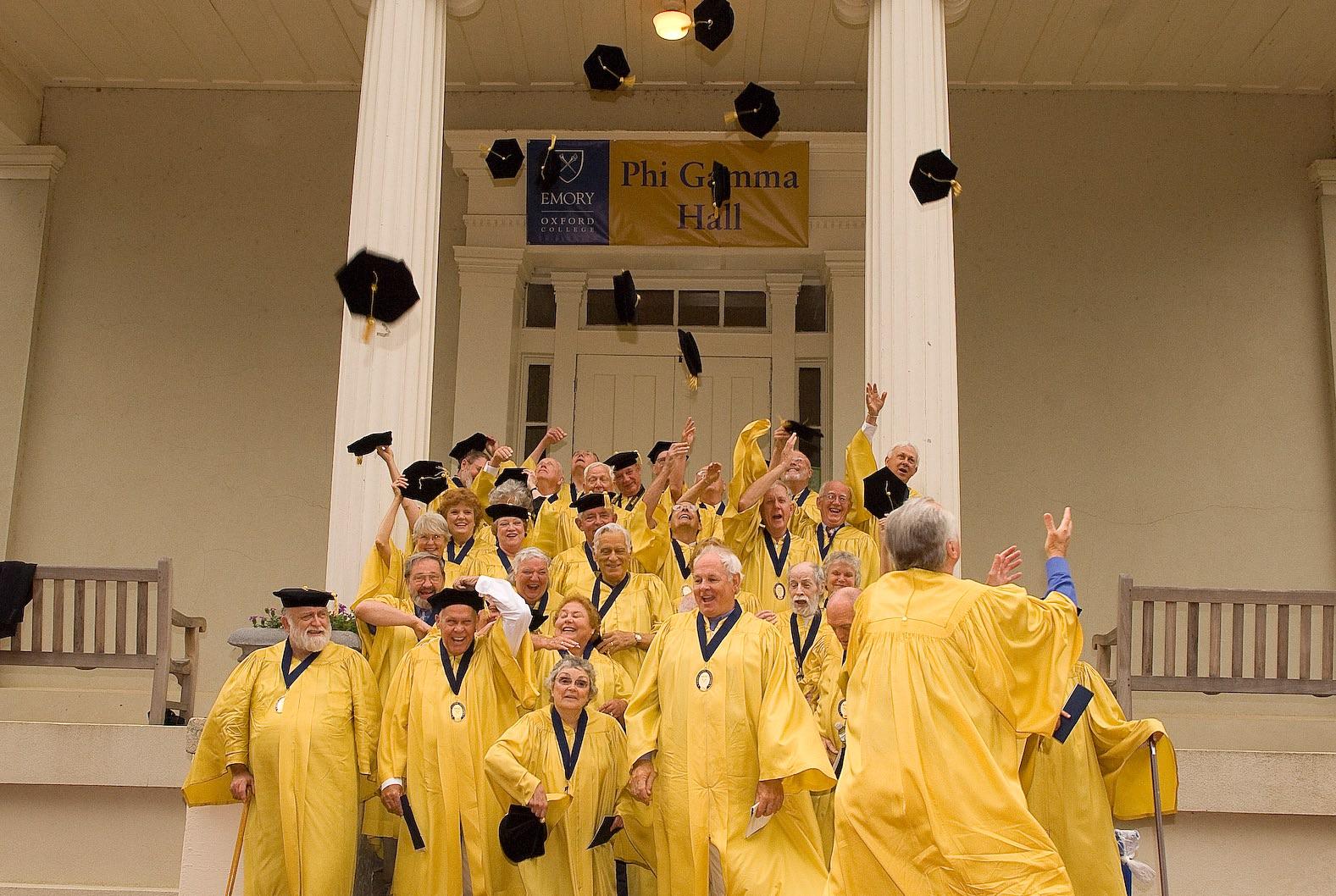
42 Coming Home
44 alumni ink
52 Coda: alice Walker
Photo by Kay Hinton. alumni news and class notesFor the past several autumns during Emory Homecoming Weekend, the Emory Alumni Association—the entire Emory campus, really—has encouraged alumni and students alike to Catch the Spirit.
For Homecoming 2009, “Catch the Spirit” has taken on additional meaning. We’ve designated September 26, Homecoming Saturday, as Emory Spirit Day. On Emory Spirit Day, we want to blanket the world in blue and gold.
No matter where you are on September 26, we hope you’ll wear an Emory shirt, don an Emory cap, fly an Emory pennant, drink out of that plastic Emory cup you picked up at Dooley’s Ball, and show the world that you’re proud to be Emory alumni.
There are more than 110,000 alumni out there. The man living next door and the woman who manages the bank could be fellow alumni, and you might never know it. On Spirit Day, we hope to break down all those barriers and have a lot of fun while doing it. As an extra bonus, we’ll look really sharp, too. Blue and gold are an excellent color combination.
On Spirit Day, you can wear your colors for a day, but we hope you’ll make the memories last a lifetime. We invite all our spirited alumni to send us your pictures in Emory gear. We’d like to know your stories, too. Did you hold a cookout with your Emory friends or make a new friend after seeing her in the grocery store with her Emory shirt? Let us know, and we just might post your picture or reprint your story on the EAA website or in an alumni publication such as this one.
To learn more about Spirit Day, including how to submit photos and even purchase discounted Emory gear, visit the Emory Spirit Day website (www.alumni.emory.edu/spiritday).
One place where we’ll see a lot of Emory shirts September 24 through 26 is campus, but Spirit Day is just one aspect of Emory Homecoming Weekend. From Oxford to Atlanta, Emory alumni, students, parents, faculty, and staff will be celebrating our community at dozens of events.
Among our thousands of campus visitors will be hundreds of alumni who’ve returned to Emory for their class reunions. If your graduation year ended in a “4” or a “9,” whether you were an undergraduate or graduate student, this is your reunion year. During the past few years, Emory’s reunions have exploded in popularity (and fun). So many things have changed about campus (classroom buildings, residence halls) and your classmates (hairlines, waistlines), yet so many things have stayed the same (friendliness, attractiveness of both the campus and, I’m certain, you and your friends)—your class reunion is an experience not to be missed.
You can find out more information on our Reunions webpage at www. alumni.emory.edu/reunions. The EAA sends most of its reunion updates electronically, and we don’t want you to miss a message. If your address information isn’t up to date, please visit the EAA’s main website at www.alumni.emory.edu and click on “Update Your Info.”
At reunion time or anytime, there are many ways to stay connected to your alma mater. The EAA’s website is your most comprehensive source for alumni news, and it’s updated nearly every day. You can register for alumni events anywhere in the world, update your alumni information, and much more.
You can follow the EAA on Twitter (www.twitter.com/EmoryAlumni) or read our regular updates on EAAvesdropping, the EAA’s blog (eaavesdropping. blogspot.com). E-Connection (www.
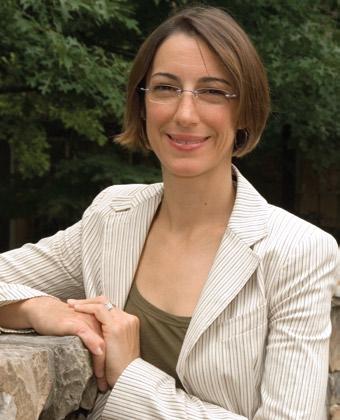
emory.edu/econnection) is our online social and professional community that now boasts more than three thousand members. If you want to connect with your fellow alumni, E-Connection is the place to do it.
Have a great summer, and I hope I’ll see many of you—especially our reunion classes—on campus this fall for Emory Homecoming Weekend. And don’t forget to include a trip to the MillerWard Alumni House during your visit. It truly is the house that you built. And if you can’t make it back, I look forward to browsing all of your pictures from Emory Spirit Day no matter where you are. If you have any questions about the EAA or Emory in general, please send me an email at adykes@emory.edu. It’s always a pleasure hearing from you.
now through september 30, you can catch the emory spirit at a discount! Visit www.emory.bkstr.com, enter “spirit 2009,” and save 15% on all emory clothing and gifts.
Whether you’re on campus for emory homecoming Weekend or anywhere else around the world you can catch the emory spirit on september 26. put on your emory shirt or your eagle cap and show the world you are proud to be emory.
show your emory colors for a day. enjoy the benefits for a lifetime.
WWW.alumni.emory.e


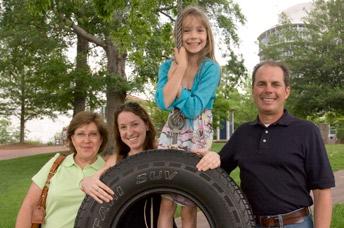
The Class of 2009 numbers some 3,800 new graduates; one wonders just how many times the word “congratulations” was spoken, whispered, or shouted during the five-day celebration of Emory Commencement Weekend May 7 through 11, 2009.
“Everything about Commencement Weekend was spectacular. We had record attendance at several events,” says Cassie Young 07C, the EAA’s coordinator for alumni programs. “In some cases, like the Legacy Reception for families with multiple generations of alumni, it was standing room only.”
Perhaps no group was more excited than the undergraduate Class of 1959, on campus for its fifty-year reunion. Attendance at the reunion numbered more than two hundred guests, and more than 135 alumni were inducted into Corpus Cordis Aureum, the EAA’s special group of alumni from half a century ago and earlier.
Since its launch in 2004, more than 640 alumni have been inducted into Corpus Cordis Aureum (Latin for “The Golden Corps of the Heart”). Membership includes a gold medallion and the honor of marching on the Quadrangle on Commencement Monday wearing specially designed gold robes.
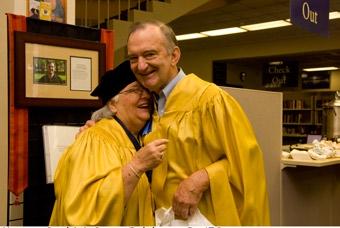

“We so much enjoyed the events associated with the reunion,” said Nancy King Scoggins 59C, who attended with husband Bob 53C 57M 60MR and was
on the list of this year’s Corpus Cordis Aureum inductees. “It was wonderful to see so many people from our past and to remember those who were not present.”
While the Class of 1959 made its mark once again on campus, it was the Class of 2009 that was star of the show. From the moment they crossed the Houston Mill bridge during the Candlelight Crossover to the moment they crossed the stage to receive their diplomas, the new graduates’ energy and excitement pulsated across campus.
“The Candlelight Crossover in particular was very meaningful,” said Erin Crews 09C 09G, a new alumna from Raleigh, North Carolina. “Receiving such a warm welcome from generations of Emory alumni on the other side was surprisingly emotional.”—
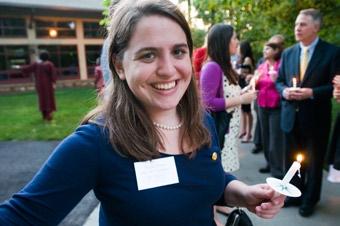
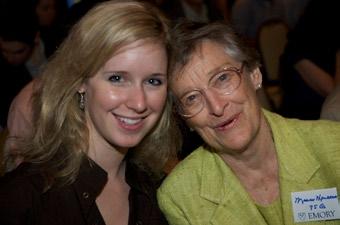

 Eric Rangus
Eric Rangus
C ele B ration: Clockwise from top, a proud family gets in the swing at the Block p arty; seniors on the bridge; m aria town 09C, student g overnment a ssociation president, carries a flame; Bill Daniel 73ox 75C and linda Daniel 75C celebrate their son thomas 07ox 09C, the third generation of Daniels at e mory, at the l egacy Brunch; the g regory family, susan 77ox 79C, Kate 09C, and luke 76ox 78C, whose father taught at o xford and whose mother served as a librarian there; and anna heilbrun 09C with her grandmother, m arian h eilbrun 75g
re available where state aws and regu a ions allow, and may vary by state. To the extent permitted by aw, appl cants are ndividually underwr tten; except n Massachusetts, not all applicants may qual fy. †Accident Forgiveness coverage subject to terms and condit ons of Liberty Mutual’s underwr t ng guidel nes and s not available in all states. Coverage provided and underwr tten by Liberty Mu ual Insurance Company and its affi iates, 175 Berkeley Street, Boston, MA. A consumer report from
pioneering airwoman anna yegorova piloted combat missions for the former Soviet Union during World War ii, survived imprisonment at a nazi camp, and was later freed only to be suspected of treason by her country’s secret police. Through compelling anecdotes, yegorova tells her inspiring life story in Red Sky, Black Death: A Soviet Woman
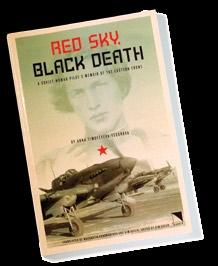
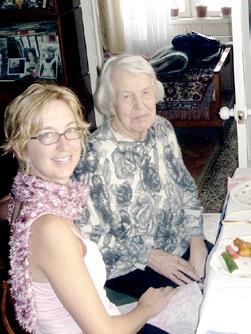
Pilot’s Memoir of the Eastern Front (Slavica publishers, 2009). The memoir was edited and cotranslated from russian by Kim green 92C, a russian major at emory who also has worked as a flight instructor. Red Sky, Black Death delves not only into the war itself, but also into the meaningful camaraderie yegorova shared with the other members of her regiment.
spiritual Connections: The daily demands of work, school, family, and friends often leave little time for reflection. in Simply Connect: Morning and Evening Prayers for 31 Days (The peppertree press, 2008), retired United Methodist pastor archie Buie 71t helps readers reconnect with god in their everyday lives. The book provides a month-long spiritual journey founded around simple, unique, and uplifting prayers.
Building history: In Bungalow Homes for the Nation (Shawnee County Historical Society, 2008), max movsovitz 85C, who has a background in historic preservation, explores the architectural legacy of a small Midwestern bungalow plan company that grew into one of the nation’s largest house plan companies. Filled with illustrations, the book examines architectural styles from Tudor revival to Cape Cod. recently, Movsovitz restored a historic home of his own, a 1924 Craftsman bungalow in Lawrence, kansas.
Colonial Dining room politics: During the 1600s, english citizens believed that diet influenced not only health, but character as well. While the country’s laborers were forced to dine on coarse scraps, the wealthy enjoyed a wide array of refined foods. These delicacies, which
were thought to produce virtue and sophistication, reinforced an aristocrat’s elite position in society. trudy eden 77l explores the history of this social phenomenon and its influence on the colonization of america in The Early American Table: Food and Society in the New World (northern illinois University press, 2008).
Close encounters of the psychic Kind: Following a series of phone calls with greta alexander, a woman who believed she gained psychic abilities after being struck by lightning, leon e. Curry 59C 62m conducted some of the first scientific experiments in psychic medical diagnosis. in The Doctor and the Psychic (BookSurge, 2008), Curry discusses these experiments and alexander’s tested ability to diagnose patients’ diseases by simply examining a handprint. Curry’s story encourages scientists to continue their study of the connection between psychic abilities and medical diagnosis.
middle eastern Conflicts: in Hamas vs. Fatah: The Struggle for Palestine (palgrave Macmillan, 2008), Jonathan schanzer 94C examines the internal palestinian rivalry that may be stifling recent peace efforts in the Middle east. Schanzer is the director of policy at the Jewish policy Center.—Franchesca Winters 10C

Until January, ryan smith 95C hadn’t set foot on american soil for nearly five years. He hasn’t had daily access to electricity, running water, or the internet for more than a decade. Smith, who joined the peace Corps in the summer of 1998, now lives in perere, a traditional african village.
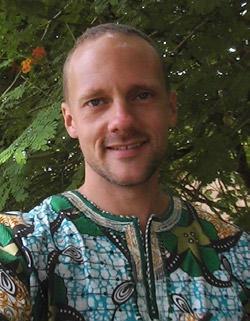
“Coming back has been strange, because in almost eleven years, i’ve only been back three times,” Smith said during a recent visit to atlanta.
Smith spent three years working with local environmental groups after graduating from emory College with a degree in human and natural ecology. Then, without telling his family or friends, he rode his bicycle into downtown atlanta and underwent the peace Corps’ rigorous application process.

Fluent in French, Smith was sent to the republic of Benin, a small, poverty-stricken Francophone country on africa’s western coast. “These people live like they’ve been living for the last several hundred years just
because nothing else has arrived to take its place,” Smith says.
Smith enlisted a young villager to tutor him in the local Baatonum. He founded an environmentally focused youth club and secured a small grant from the peace Corps when his students expressed interest in starting a tree nursery. During the club’s first year, Smith and his students planted nearly three thousand trees and the project gained the interest of both perere’s chief and the region’s king, who suggested that Smith establish a nature reserve.“They set aside a little piece of land, and then we had a party and went out and planted the trees,” Smith says. “There was traditional music, dance, food. it was a big success.”
Smith didn’t leave Benin when his two-year commitment ended. instead, he
chose to remain in perere at the request of his Beninese friends and host family, expecting to stay no more than another year or two. He continued his work with the reserve and also assumed responsibility for ten children who had been orphaned by the death of a member of Smith’s host family in 1998.
Smith now serves as executive director of the reserve’s regional Council and of the reserve itself, the antisua Community Forest, which has grown to include nearly fifteen thousand acres. although he has wholeheartedly embraced his life in africa, Smith remains unsure where the next few years will take him. “i feel every bit at home in that village now, but i miss my life here too,” he says. “My big challenge in life will be to find out how to have both at once.”—Franchesca Winters 10C
Yes, you have my strong support for Emory University. Please accept my tax-deductible gift of $ to the Annual Fund to help preserve and improve the distinctive features of the University’s educational programs.
I hereby pledge to Emory University the sum of $ . I intend to pay my pledge as follows: monthly quarterly other (please specify)
I have enclosed a check for $ payable to Emory University.
I prefer to charge my gift to my VISA MasterCard American Express
Please direct my gift to support: Name(s)
For class notes, please visit www.alumniconnections.com/emory.
Please send me more information about:
■ Gifts that pay me income (Charitable trusts and Annuities)
■ Gifts of Appreciated Assets including Stocks and Real estate
■ Creating a named Scholarship or other endowment Fund at emory
■ Including emory in my Will or trust
■ other:
Emory Annual Fund 1762 Clifton Road Suite 1400 Atlanta GA 30322-4001
Telephone: 404.727.6200
Fax: 404.727.8786 emoryaf@emory.edu
Is emory in your will or other testamentary plans?
■ yes ■ no
■ Would Consider
■ My employer will match my gift. name of Company
■ My spouse’s/partner’s employer will match my gift. name of Company
Please contact your personnel or human resources office for eligibility information and to obtain a matching gift form. Enclose the completed form with your contribution. We will verify your contribution and return the form to your employer, who will send the matching gift directly to Emory upon approval. We appreciate your efforts to maximize the available resources to ensure a bright future for Emory and its students.
you also may make your gift online at www.emory.edu/give.
2010 JOURNEYS OF DISCOVERY
River Life along the Amazon
January 15-24, 2010 — From $3,695 (plus air)
Cruise the Panama Canal
February 3-14, 2010 — From $2,795 (plus air)
Legends of the Nile
February 9-20, 2010 — From $3,995 (plus air)
Galapagos
April 3-12, 2010 — From $4,842 (plus air)
Treasures of Morocco
April 11-20, 2010 — From $2,995 (plus air)
Waterways and Canals of Holland & Belgium
April 13-21, 2010 — From $2,295 (plus air)
Insiders London
April 28-May 4, 2010 — From $2,095 (plus air)
Sicily ~ Syracuse & Palermo
May 7-17, 2010 — From $2,995 (plus air)
Italian Riviera & Chianti
May 19-28, 2010 — From $2,595 (plus air)
Grand Journey Turkey
May 19-30, 2010 — From $2,995 (plus air)
Grand Journey Ireland
May 21-June 2, 2010 — From $3,495 (plus air)
Village Life in Dordogne
May 20-28, 2010 — From $2,895 (plus air)
The Great Journey through Europe
June 22-July 2, 2010 — From $3,195 (plus air)
Vikings, Kings, and Castles
June 29-July 12, 2010 — From $3,499 (airfare included)


Canadian Maritimes
July 26-August 4, 2010 — From $2,995 (plus air)
European Mosaic
August 23-September 5, 2010
From $3,499 (airfare included)
Waterways of Russia
September 2-12, 2010 —
From $2,995 (plus air)
Classic China
October 5-18, 2010
From $3,195 (plus air)
Classic Greek Isles
October 11-26, 2010
From $3,995 (plus air)
In the Wake of Lewis and Clark
October 23-29, 2010
From $3,255 (plus air)
Treasures of Southern Africa
October 31-
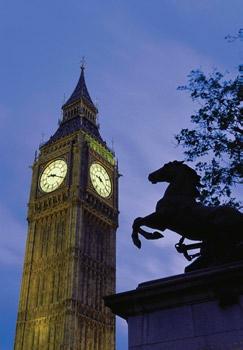
The coming year brings opportunities to discover new places and fresh faces around the world while revisiting some old, beautiful favorites. We are dedicated to giving travelers like you enriching cultural experiences to enhance your lifelong education while strengthening your connection with faculty, other alumni and friends of Emory.
If you would like additional information about our trips for 2010 or are interested in being added to our travel mailing list, please email alumnitravel@emory.edu or contact the Emory Travel Program at 404.727.6479.
The information and dates above are based on information provided by our travel vendors as of July 2009 and are subject to change. Individual trip brochures will be available to be mailed out approximately 9–12 months prior to the trip’s departure.
November 14, 2010 From $5,895 (plus air)
Holiday Markets on the Danube
November 29-December 7, 2010
From $1,995 (plus air)
All Emory Travel Program tours require that participants be in good physical condition. Each traveler must be capable, without assistance, of walking a minimum of one mile over uneven terrain and of climbing stairs that may not have handrails. Participants should have sufficient stamina to keep pace with an active group of travelers on long days of touring. If you have any questions about your ability to participate in a tour, please call the Emory Travel Program at 404.727.6479
social events in your City alumni travel program
emory Career network Database
alumni Career Coaching
insurance Benefits
emory Credit Card
Free lifetime email address
e-Class notes
online alumni Directory
Kaplan test prep Discounts
alllearn online Courses
lifelong learning Discounts
Banking at emory Credit union young alumni activities emory speakers in your City intramural sports and much more!
Find it all on our website at www.alumni.emory.edu/privileges, or call the emory alumni association at 404.727.6400.
submit Class notes. Mail to: Alumni Records Department, Emory University, 1762 Clifton Road, Atlanta, Georgia 30322. FAX 404.727.4876.
Please mark address corrections directly onto your current Emory Magazine mailing label. eurec@emory.edu; www.alumni.emory.edu
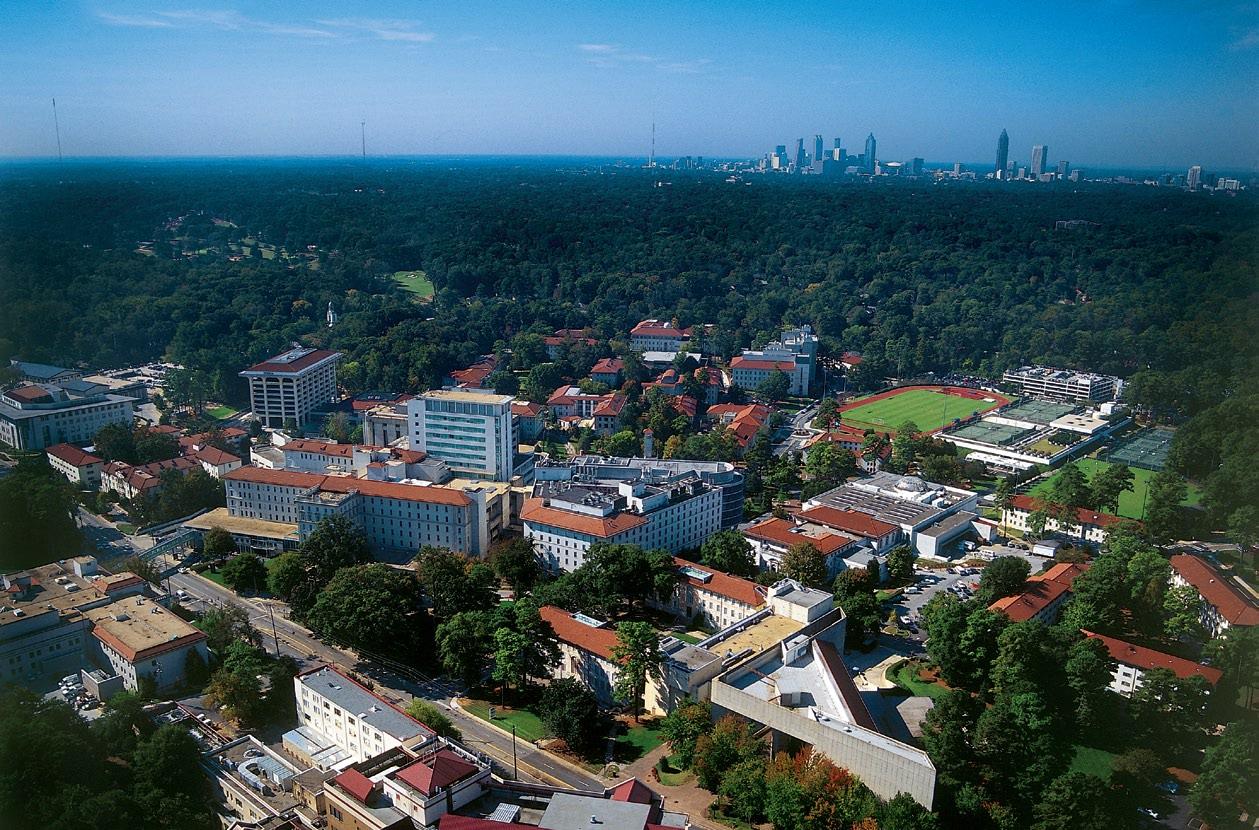
Name
College/School
Title: ☐ Dr. ☐ Mr. ☐ Ms. ☐ Mrs. ☐ Miss ☐ Rev.
Spouse/partner’s name and class year(s)
Degree(s) Class year(s)
Major(s)
Home address (☐ check if new) City
State ZIP Country
Home phone Email
My firm, employer, or professional specialty (☐ check if new)
Title
Prefer contact at ☐ home ☐ work
Business address City
State ZIP Country
Business phone Fax Email
Please include the following news in Emory Magazine.
(your class note may not appear for up to six months following submission. please do not resubmit Emory Magazine does not publish engagement announcements; submit wedding announcements after the ceremony has taken place. For birth announcements, include the names of both parents. please provide a daytime telephone number in email submissions.)
John spurgeon howett, who died april 8 at eighty-two, was an ardent advocate for the arts and a distinguished professor and mentor at emory. Born in kokomo, indiana, Howett served with the U.S. infantry during World War ii. He went on to earn a BFa in from the John Herron art institute in indianapolis and a phD from the University of Chicago. a specialist in the art of the italian renaissance, he was recruited by emory in 1966 to help build its new program in art history. During his thirty-year career, Howett received many awards for teaching and service, including the 2009 Woolford B. Baker award for lifelong service to emory and to the Carlos Museum. Howett and his wife of fifty-two years, Catherine, had four daughters: Meghan 80C 83L, Maeve 82C 85n 97Mn 06g, Catherine 84C 99g, and Ciannat 87C; Maeve, Ciannat, and Catherine hold positions at emory, and Meghan serves on the Board of visitors.
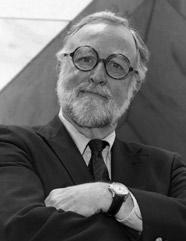
For class notes, please visit www.alumniconnections.com/emory.
eD i TO r’ S nOT e: Class notes are submitted by alumni and are not verified by the editors. While we welcome alumni news, emory Magazine is not responsible for information contained in class notes.
Thursday, December 4, 2008
Today, a few hours before sunset, I went with friends to place sixty-four tiny turtles back into the ocean. They had come ashore months before as embryos in their mothers’ bodies. The mothers had laid the soft, leathery eggs in deep, undersand nests, covered them carefully, and left them to hatch, before returning to the ocean’s depths. My sweetheart and I had walked our dog along their nesting trail in May, marveling at the igloo-like bubbles that covered the beach. Now, in early December, under large plastic buckets, dozens of baby turtles wriggled and crawled, over and over each other, and into our lucky hands.
That is what I felt, incredibly lucky to be there to help them go home. Home to a giant sea that, even as we lifted the tiny dark gray milagros de la vida (miracles of life) from the sand, roared and crashed against the shore, sending foam and spray well above our heads.
 By a L i C e W a L ker
By a L i C e W a L ker
I have been coming to this beach in Mexico, this same stretch of ocean, for twenty years; but never at the right time. Usually I have been writing in such seclusion I’ve missed this astonishing event. Two years ago I came to help with the turtles for the first time. It was one of my most intense spiritual experiences. Them, so dark, suede scaled, and determined; me, speechless to find them so tiny that five of them, if they were still, might fit in one hand; yet knowing their way home. Scooping them out of the bucket, we barely had a moment to
prevent them from falling from our hands, before they, flippers working ceaselessly, followed the smell of the sea, the spray on their bodies, and began making a dash, their kind of dash, more like a happy waddle, to the water. Going back to Mother.
Not many of them will survive their journey to adulthood. They will fall prey to many predators before they are the huge size a few of them will attain. But some will make it, and come ashore years from now as mothers themselves, ready to start the cycle all over again. I said to my sweetheart how odd it must seem to the turtles to have lived eons without needing the help of humans to keep their numbers viable, after having been hunted almost to extinction. Then I thought of how long it would take for our intervention in the cycle to become a part of what the turtles expect; a part of their DNA. We laughed, thinking of the baby turtles to come, scrambling around in the coming thousands of years, patiently waiting for us. Where’s that human hand that’s supposed to appear around about now, they would ask themselves. We laughed more, if soberly, hoping that, with still more luck, we—as that human hand— would always, if still needed, be there.
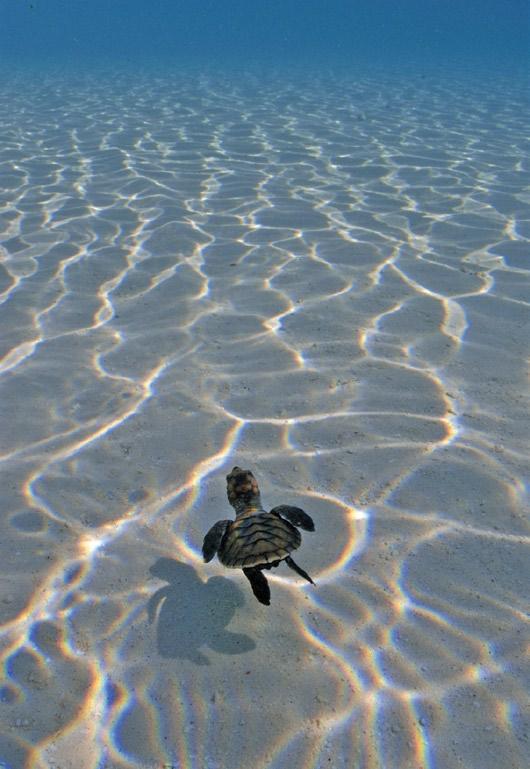
Kamal mansour 68mr began his career in 1966 as chief resident in cardiothoracic surgery at Emory university Hospital. an international pioneer of lifesaving techniques, he has shared his passion for medicine with thousands of students, faculty members, and patients for 41 years now. His residents dubbed him “the Tasmanian devil” for his speed in surgery and “the professor” for his devotion to teaching.
now mansour is making an endless contribution to thoracic surgery at Emory: He and his wife, Cleo, have established the Kamal a. mansour Professorship through a provision in their wills.

“I am indebted to Emory for my many years of association here,” he says. “I wanted to express my gratitude.”
learn how you can support Emory in your estate plans. Visit www.emory.edu/giftplanning or call 404.727.8875.
Plan to say thank you.
